
Research Topics & Ideas
Biotechnology and Genetic Engineering

If you’re just starting out exploring biotechnology-related topics for your dissertation, thesis or research project, you’ve come to the right place. In this post, we’ll help kickstart your research topic ideation process by providing a hearty list of research topics and ideas , including examples from recent studies.
PS – This is just the start…
We know it’s exciting to run through a list of research topics, but please keep in mind that this list is just a starting point . To develop a suitable research topic, you’ll need to identify a clear and convincing research gap , and a viable plan to fill that gap.
If this sounds foreign to you, check out our free research topic webinar that explores how to find and refine a high-quality research topic, from scratch. Alternatively, if you’d like hands-on help, consider our 1-on-1 coaching service .

Biotechnology Research Topic Ideas
Below you’ll find a list of biotech and genetic engineering-related research topics ideas. These are intentionally broad and generic , so keep in mind that you will need to refine them a little. Nevertheless, they should inspire some ideas for your project.
- Developing CRISPR-Cas9 gene editing techniques for treating inherited blood disorders.
- The use of biotechnology in developing drought-resistant crop varieties.
- The role of genetic engineering in enhancing biofuel production efficiency.
- Investigating the potential of stem cell therapy in regenerative medicine for spinal cord injuries.
- Developing gene therapy approaches for the treatment of rare genetic diseases.
- The application of biotechnology in creating biodegradable plastics from plant materials.
- The use of gene editing to enhance nutritional content in staple crops.
- Investigating the potential of microbiome engineering in treating gastrointestinal diseases.
- The role of genetic engineering in vaccine development, with a focus on mRNA vaccines.
- Biotechnological approaches to combat antibiotic-resistant bacteria.
- Developing genetically engineered organisms for bioremediation of polluted environments.
- The use of gene editing to create hypoallergenic food products.
- Investigating the role of epigenetics in cancer development and therapy.
- The application of biotechnology in developing rapid diagnostic tools for infectious diseases.
- Genetic engineering for the production of synthetic spider silk for industrial use.
- Biotechnological strategies for improving animal health and productivity in agriculture.
- The use of gene editing in creating organ donor animals compatible with human transplantation.
- Developing algae-based bioreactors for carbon capture and biofuel production.
- The role of biotechnology in enhancing the shelf life and quality of fresh produce.
- Investigating the ethics and social implications of human gene editing technologies.
- The use of CRISPR technology in creating models for neurodegenerative diseases.
- Biotechnological approaches for the production of high-value pharmaceutical compounds.
- The application of genetic engineering in developing pest-resistant crops.
- Investigating the potential of gene therapy in treating autoimmune diseases.
- Developing biotechnological methods for producing environmentally friendly dyes.

Biotech & GE Research Topic Ideas (Continued)
- The use of genetic engineering in enhancing the efficiency of photosynthesis in plants.
- Biotechnological innovations in creating sustainable aquaculture practices.
- The role of biotechnology in developing non-invasive prenatal genetic testing methods.
- Genetic engineering for the development of novel enzymes for industrial applications.
- Investigating the potential of xenotransplantation in addressing organ donor shortages.
- The use of biotechnology in creating personalised cancer vaccines.
- Developing gene editing tools for combating invasive species in ecosystems.
- Biotechnological strategies for improving the nutritional quality of plant-based proteins.
- The application of genetic engineering in enhancing the production of renewable energy sources.
- Investigating the role of biotechnology in creating advanced wound care materials.
- The use of CRISPR for targeted gene activation in regenerative medicine.
- Biotechnological approaches to enhancing the sensory qualities of plant-based meat alternatives.
- Genetic engineering for improving the efficiency of water use in agriculture.
- The role of biotechnology in developing treatments for rare metabolic disorders.
- Investigating the use of gene therapy in age-related macular degeneration.
- The application of genetic engineering in developing allergen-free nuts.
- Biotechnological innovations in the production of sustainable and eco-friendly textiles.
- The use of gene editing in studying and treating sleep disorders.
- Developing biotechnological solutions for the management of plastic waste.
- The role of genetic engineering in enhancing the production of essential vitamins in crops.
- Biotechnological approaches to the treatment of chronic pain conditions.
- The use of gene therapy in treating muscular dystrophy.
- Investigating the potential of biotechnology in reversing environmental degradation.
- The application of genetic engineering in improving the shelf life of vaccines.
- Biotechnological strategies for enhancing the efficiency of mineral extraction in mining.
Recent Biotech & GE-Related Studies
While the ideas we’ve presented above are a decent starting point for finding a research topic in biotech, they are fairly generic and non-specific. So, it helps to look at actual studies in the biotech space to see how this all comes together in practice.
Below, we’ve included a selection of recent studies to help refine your thinking. These are actual studies, so they can provide some useful insight as to what a research topic looks like in practice.
- Genetic modifications associated with sustainability aspects for sustainable developments (Sharma et al., 2022)
- Review On: Impact of Genetic Engineering in Biotic Stresses Resistance Crop Breeding (Abebe & Tafa, 2022)
- Biorisk assessment of genetic engineering — lessons learned from teaching interdisciplinary courses on responsible conduct in the life sciences (Himmel et al., 2022)
- Genetic Engineering Technologies for Improving Crop Yield and Quality (Ye et al., 2022)
- Legal Aspects of Genetically Modified Food Product Safety for Health in Indonesia (Khamdi, 2022)
- Innovative Teaching Practice and Exploration of Genetic Engineering Experiment (Jebur, 2022)
- Efficient Bacterial Genome Engineering throughout the Central Dogma Using the Dual-Selection Marker tetAOPT (Bayer et al., 2022)
- Gene engineering: its positive and negative effects (Makrushina & Klitsenko, 2022)
- Advances of genetic engineering in streptococci and enterococci (Kurushima & Tomita, 2022)
- Genetic Engineering of Immune Evasive Stem Cell-Derived Islets (Sackett et al., 2022)
- Establishment of High-Efficiency Screening System for Gene Deletion in Fusarium venenatum TB01 (Tong et al., 2022)
- Prospects of chloroplast metabolic engineering for developing nutrient-dense food crops (Tanwar et al., 2022)
- Genetic research: legal and ethical aspects (Rustambekov et al., 2023). Non-transgenic Gene Modulation via Spray Delivery of Nucleic Acid/Peptide Complexes into Plant Nuclei and Chloroplasts (Thagun et al., 2022)
- The role of genetic breeding in food security: A review (Sam et al., 2022). Biotechnology: use of available carbon sources on the planet to generate alternatives energy (Junior et al., 2022)
- Biotechnology and biodiversity for the sustainable development of our society (Jaime, 2023) Role Of Biotechnology in Agriculture (Shringarpure, 2022)
- Plants That Can be Used as Plant-Based Edible Vaccines; Current Situation and Recent Developments (İsmail, 2022)
As you can see, these research topics are a lot more focused than the generic topic ideas we presented earlier. So, in order for you to develop a high-quality research topic, you’ll need to get specific and laser-focused on a specific context with specific variables of interest. In the video below, we explore some other important things you’ll need to consider when crafting your research topic.
Get 1-On-1 Help
If you’re still unsure about how to find a quality research topic, check out our Research Topic Kickstarter service, which is the perfect starting point for developing a unique, well-justified research topic.

You Might Also Like:

Submit a Comment Cancel reply
Your email address will not be published. Required fields are marked *
Save my name, email, and website in this browser for the next time I comment.
- Print Friendly
200+ Biotechnology Research Topics: Let’s Shape the Future
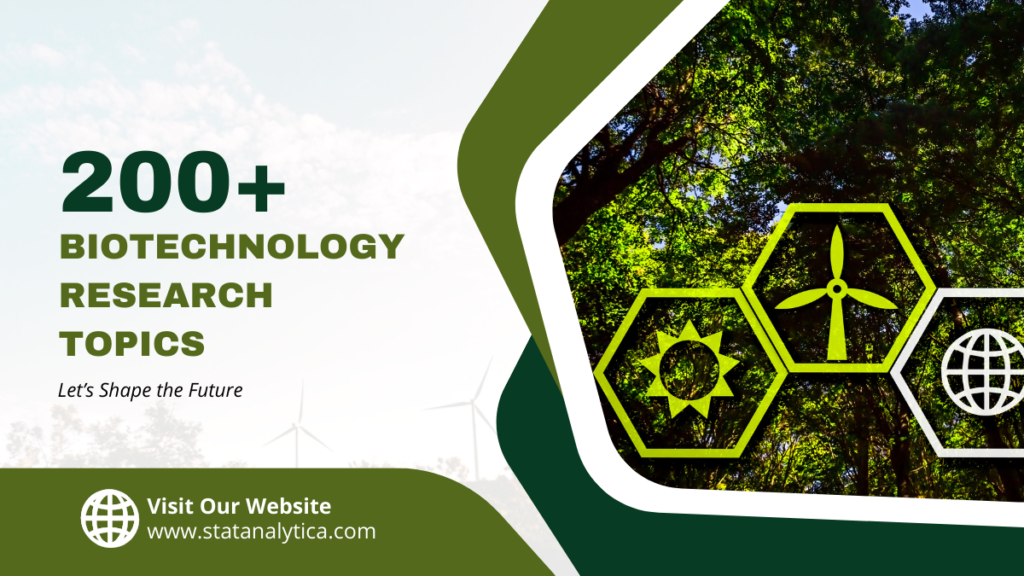
In the dynamic landscape of scientific exploration, biotechnology stands at the forefront, revolutionizing the way we approach healthcare, agriculture, and environmental sustainability. This interdisciplinary field encompasses a vast array of research topics that hold the potential to reshape our world.
In this blog post, we will delve into the realm of biotechnology research topics, understanding their significance and exploring the diverse avenues that researchers are actively investigating.
Overview of Biotechnology Research
Table of Contents
Biotechnology, at its core, involves the application of biological systems, organisms, or derivatives to develop technologies and products for the benefit of humanity.
The scope of biotechnology research is broad, covering areas such as genetic engineering, biomedical engineering, environmental biotechnology, and industrial biotechnology. Its interdisciplinary nature makes it a melting pot of ideas and innovations, pushing the boundaries of what is possible.
How to Select The Best Biotechnology Research Topics?
- Identify Your Interests
Start by reflecting on your own interests within the broad field of biotechnology. What aspects of biotechnology excite you the most? Identifying your passion will make the research process more engaging.
- Stay Informed About Current Trends
Keep up with the latest developments and trends in biotechnology. Subscribe to scientific journals, attend conferences, and follow reputable websites to stay informed about cutting-edge research. This will help you identify gaps in knowledge or areas where advancements are needed.
- Consider Societal Impact
Evaluate the potential societal impact of your chosen research topic. How does it contribute to solving real-world problems? Biotechnology has applications in healthcare, agriculture, environmental conservation, and more. Choose a topic that aligns with the broader goal of improving quality of life or addressing global challenges.
- Assess Feasibility and Resources
Evaluate the feasibility of your research topic. Consider the availability of resources, including laboratory equipment, funding, and expertise. A well-defined and achievable research plan will increase the likelihood of successful outcomes.
- Explore Innovation Opportunities
Look for opportunities to contribute to innovation within the field. Consider topics that push the boundaries of current knowledge, introduce novel methodologies, or explore interdisciplinary approaches. Innovation often leads to groundbreaking discoveries.
- Consult with Mentors and Peers
Seek guidance from mentors, professors, or colleagues who have expertise in biotechnology. Discuss your research interests with them and gather insights. They can provide valuable advice on the feasibility and significance of your chosen topic.
- Balance Specificity and Breadth
Strike a balance between biotechnology research topics that are specific enough to address a particular aspect of biotechnology and broad enough to allow for meaningful research. A topic that is too narrow may limit your research scope, while one that is too broad may lack focus.
- Consider Ethical Implications
Be mindful of the ethical implications of your research. Biotechnology, especially areas like genetic engineering, can raise ethical concerns. Ensure that your chosen topic aligns with ethical standards and consider how your research may impact society.
- Evaluate Industry Relevance
Consider the relevance of your research topic to the biotechnology industry. Industry-relevant research has the potential for practical applications and may attract funding and collaboration opportunities.
- Stay Flexible and Open-Minded
Be open to refining or adjusting your research topic as you delve deeper into the literature and gather more information. Flexibility is key to adapting to new insights and developments in the field.
200+ Biotechnology Research Topics: Category-Wise
Genetic engineering.
- CRISPR-Cas9: Recent Advances and Applications
- Gene Editing for Therapeutic Purposes: Opportunities and Challenges
- Precision Medicine and Personalized Genomic Therapies
- Genome Sequencing Technologies: Current State and Future Prospects
- Synthetic Biology: Engineering New Life Forms
- Genetic Modification of Crops for Improved Yield and Resistance
- Ethical Considerations in Human Genetic Engineering
- Gene Therapy for Neurological Disorders
- Epigenetics: Understanding the Role of Gene Regulation
- CRISPR in Agriculture: Enhancing Crop Traits
Biomedical Engineering
- Tissue Engineering: Creating Organs in the Lab
- 3D Printing in Biomedical Applications
- Advances in Drug Delivery Systems
- Nanotechnology in Medicine: Theranostic Approaches
- Bioinformatics and Computational Biology in Biomedicine
- Wearable Biomedical Devices for Health Monitoring
- Stem Cell Research and Regenerative Medicine
- Precision Oncology: Tailoring Cancer Treatments
- Biomaterials for Biomedical Applications
- Biomechanics in Biomedical Engineering
Environmental Biotechnology
- Bioremediation of Polluted Environments
- Waste-to-Energy Technologies: Turning Trash into Power
- Sustainable Agriculture Practices Using Biotechnology
- Bioaugmentation in Wastewater Treatment
- Microbial Fuel Cells: Harnessing Microorganisms for Energy
- Biotechnology in Conservation Biology
- Phytoremediation: Plants as Environmental Cleanup Agents
- Aquaponics: Integration of Aquaculture and Hydroponics
- Biodiversity Monitoring Using DNA Barcoding
- Algal Biofuels: A Sustainable Energy Source
Industrial Biotechnology
- Enzyme Engineering for Industrial Applications
- Bioprocessing and Bio-manufacturing Innovations
- Industrial Applications of Microbial Biotechnology
- Bio-based Materials: Eco-friendly Alternatives
- Synthetic Biology for Industrial Processes
- Metabolic Engineering for Chemical Production
- Industrial Fermentation: Optimization and Scale-up
- Biocatalysis in Pharmaceutical Industry
- Advanced Bioprocess Monitoring and Control
- Green Chemistry: Sustainable Practices in Industry
Emerging Trends in Biotechnology
- CRISPR-Based Diagnostics: A New Era in Disease Detection
- Neurobiotechnology: Advancements in Brain-Computer Interfaces
- Advances in Nanotechnology for Healthcare
- Computational Biology: Modeling Biological Systems
- Organoids: Miniature Organs for Drug Testing
- Genome Editing in Non-Human Organisms
- Biotechnology and the Internet of Things (IoT)
- Exosome-based Therapeutics: Potential Applications
- Biohybrid Systems: Integrating Living and Artificial Components
- Metagenomics: Exploring Microbial Communities
Ethical and Social Implications
- Ethical Considerations in CRISPR-Based Gene Editing
- Privacy Concerns in Personal Genomic Data Sharing
- Biotechnology and Social Equity: Bridging the Gap
- Dual-Use Dilemmas in Biotechnological Research
- Informed Consent in Genetic Testing and Research
- Accessibility of Biotechnological Therapies: Global Perspectives
- Human Enhancement Technologies: Ethical Perspectives
- Biotechnology and Cultural Perspectives on Genetic Modification
- Social Impact Assessment of Biotechnological Interventions
- Intellectual Property Rights in Biotechnology
Computational Biology and Bioinformatics
- Machine Learning in Biomedical Data Analysis
- Network Biology: Understanding Biological Systems
- Structural Bioinformatics: Predicting Protein Structures
- Data Mining in Genomics and Proteomics
- Systems Biology Approaches in Biotechnology
- Comparative Genomics: Evolutionary Insights
- Bioinformatics Tools for Drug Discovery
- Cloud Computing in Biomedical Research
- Artificial Intelligence in Diagnostics and Treatment
- Computational Approaches to Vaccine Design
Health and Medicine
- Vaccines and Immunotherapy: Advancements in Disease Prevention
- CRISPR-Based Therapies for Genetic Disorders
- Infectious Disease Diagnostics Using Biotechnology
- Telemedicine and Biotechnology Integration
- Biotechnology in Rare Disease Research
- Gut Microbiome and Human Health
- Precision Nutrition: Personalized Diets Using Biotechnology
- Biotechnology Approaches to Combat Antibiotic Resistance
- Point-of-Care Diagnostics for Global Health
- Biotechnology in Aging Research and Longevity
Agricultural Biotechnology
- CRISPR and Gene Editing in Crop Improvement
- Precision Agriculture: Integrating Technology for Crop Management
- Biotechnology Solutions for Food Security
- RNA Interference in Pest Control
- Vertical Farming and Biotechnology
- Plant-Microbe Interactions for Sustainable Agriculture
- Biofortification: Enhancing Nutritional Content in Crops
- Smart Farming Technologies and Biotechnology
- Precision Livestock Farming Using Biotechnological Tools
- Drought-Tolerant Crops: Biotechnological Approaches
Biotechnology and Education
- Integrating Biotechnology into STEM Education
- Virtual Labs in Biotechnology Teaching
- Biotechnology Outreach Programs for Schools
- Online Courses in Biotechnology: Accessibility and Quality
- Hands-on Biotechnology Experiments for Students
- Bioethics Education in Biotechnology Programs
- Role of Internships in Biotechnology Education
- Collaborative Learning in Biotechnology Classrooms
- Biotechnology Education for Non-Science Majors
- Addressing Gender Disparities in Biotechnology Education
Funding and Policy
- Government Funding Initiatives for Biotechnology Research
- Private Sector Investment in Biotechnology Ventures
- Impact of Intellectual Property Policies on Biotechnology
- Ethical Guidelines for Biotechnological Research
- Public-Private Partnerships in Biotechnology
- Regulatory Frameworks for Gene Editing Technologies
- Biotechnology and Global Health Policy
- Biotechnology Diplomacy: International Collaboration
- Funding Challenges in Biotechnology Startups
- Role of Nonprofit Organizations in Biotechnological Research
Biotechnology and the Environment
- Biotechnology for Air Pollution Control
- Microbial Sensors for Environmental Monitoring
- Remote Sensing in Environmental Biotechnology
- Climate Change Mitigation Using Biotechnology
- Circular Economy and Biotechnological Innovations
- Marine Biotechnology for Ocean Conservation
- Bio-inspired Design for Environmental Solutions
- Ecological Restoration Using Biotechnological Approaches
- Impact of Biotechnology on Biodiversity
- Biotechnology and Sustainable Urban Development
Biosecurity and Biosafety
- Biosecurity Measures in Biotechnology Laboratories
- Dual-Use Research and Ethical Considerations
- Global Collaboration for Biosafety in Biotechnology
- Security Risks in Gene Editing Technologies
- Surveillance Technologies in Biotechnological Research
- Biosecurity Education for Biotechnology Professionals
- Risk Assessment in Biotechnology Research
- Bioethics in Biodefense Research
- Biotechnology and National Security
- Public Awareness and Biosecurity in Biotechnology
Industry Applications
- Biotechnology in the Pharmaceutical Industry
- Bioprocessing Innovations for Drug Production
- Industrial Enzymes and Their Applications
- Biotechnology in Food and Beverage Production
- Applications of Synthetic Biology in Industry
- Biotechnology in Textile Manufacturing
- Cosmetic and Personal Care Biotechnology
- Biotechnological Approaches in Renewable Energy
- Advanced Materials Production Using Biotechnology
- Biotechnology in the Automotive Industry
Miscellaneous Topics
- DNA Barcoding in Species Identification
- Bioart: The Intersection of Biology and Art
- Biotechnology in Forensic Science
- Using Biotechnology to Preserve Cultural Heritage
- Biohacking: DIY Biology and Citizen Science
- Microbiome Engineering for Human Health
- Environmental DNA (eDNA) for Biodiversity Monitoring
- Biotechnology and Astrobiology: Searching for Life Beyond Earth
- Biotechnology and Sports Science
- Biotechnology and the Future of Space Exploration
Challenges and Ethical Considerations in Biotechnology Research
As biotechnology continues to advance, it brings forth a set of challenges and ethical considerations. Biosecurity concerns, especially in the context of gene editing technologies, raise questions about the responsible use of powerful tools like CRISPR.
Ethical implications of genetic manipulation, such as the creation of designer babies, demand careful consideration and international collaboration to establish guidelines and regulations.
Moreover, the environmental and social impact of biotechnological interventions must be thoroughly assessed to ensure responsible and sustainable practices.
Funding and Resources for Biotechnology Research
The pursuit of biotechnology research topics requires substantial funding and resources. Government grants and funding agencies play a pivotal role in supporting research initiatives.
Simultaneously, the private sector, including biotechnology companies and venture capitalists, invest in promising projects. Collaboration and partnerships between academia, industry, and nonprofit organizations further amplify the impact of biotechnological research.
Future Prospects of Biotechnology Research
As we look to the future, the integration of biotechnology with other scientific disciplines holds immense potential. Collaborations with fields like artificial intelligence, materials science, and robotics may lead to unprecedented breakthroughs.
The development of innovative technologies and their application to global health and sustainability challenges will likely shape the future of biotechnology.
In conclusion, biotechnology research is a dynamic and transformative force with the potential to revolutionize multiple facets of our lives. The exploration of diverse biotechnology research topics, from genetic engineering to emerging trends like synthetic biology and nanobiotechnology, highlights the breadth of possibilities within this field.
However, researchers must navigate challenges and ethical considerations to ensure that biotechnological advancements are used responsibly for the betterment of society.
With continued funding, collaboration, and a commitment to ethical practices, the future of biotechnology research holds exciting promise, propelling us towards a more sustainable and technologically advanced world.
Related Posts

Step by Step Guide on The Best Way to Finance Car

The Best Way on How to Get Fund For Business to Grow it Efficiently
More From Forbes
18 new and emerging biotech developments everyone should know about.
- Share to Facebook
- Share to Twitter
- Share to Linkedin
Biotechnology comprises the study and manipulation of living organisms with the goal of creating new products and processes that can improve our health and/or standards of living. It’s a field that can lead to revolutionary new developments in everything from healthcare to food production to waste management.
Major happenings in the biotech industry can have a significant impact on humanity, the Earth and the animal kingdom, so it’s not surprising that headlines from the field are of immense interest to tech experts and the general public alike. Below, 18 members of Forbes Technology Council discuss some of the amazing new and emerging biotech tools and developments everyone should know about and why they’re so exciting.
1. Brain Mapping
In 2021, Google and Harvard announced they had mapped the equivalent of a 1-millionth section of the human brain. The resulting map took up 1.4 petabytes of disk space, comparable in size to three decades’ worth of satellite images of Earth. Once technology advances and allows us to map larger areas of the human brain, we will better understand and be able to help those with traumatic injuries or neurological disorders and diseases. - Joe McCunney , Scalar Labs
2. Autonomous Therapeutic Systems
Autonomous therapeutic systems are one of the most significant future medical technologies. These systems take over patient care from (human) providers by analyzing, determining and autonomously controlling conditions and treatments. Thus, we need to have a precise simulation of a patient’s medical condition—the patient’s bio digital twin. This should reduce human error and medical care costs. - Kazuhiro Gomi , NTT Research
Forbes Technology Council is an invitation-only community for world-class CIOs, CTOs and technology executives. Do I qualify?
Best High-Yield Savings Accounts Of 2024
Best 5% interest savings accounts of 2024, 3. alphafold.
AlphaFold is a protein folding program developed by Google’s DeepMind. It’s a major breakthrough in the field of protein folding. By understanding how proteins fold, we can better understand how they work and how they can be manipulated to improve human health. Additionally, we can more quickly design better drugs that will bind to their targets with greater specificity and affinity. - Sandeep Singh , Beans.AI
4. Cellular Anti-Aging Research
One of the biggest areas of biotech research right now is anti-aging at the cellular level. Researchers believe that we can actually reverse aging, which could not only help people live longer, but could also provide cures or treatments for diseases that are incurable today. There are ethical issues to be worked out, but the potential to change life as we know it is exciting. - Lior Yaari , Grip Security
5. CRISPR-Based Gene Editing
One thrilling biotech breakthrough is CRISPR-based gene editing. This technique allows precise modifications to DNA, offering potential cures for genetic disorders. For the general public, the implications are vast, including everything from addressing inheritable diseases to revolutionizing agriculture. Imagine a future where we could eliminate conditions such as cystic fibrosis or grow drought-resistant crops. - Miguel Llorca , Torrent Group
6. Microbiome Manipulation
Manipulation of the microbiome is exciting everyone. The study of the numerous microbes that reside within our bodies indicates that their impact on our health extends beyond digestion. Leveraging this understanding has the potential to pave the way for personalized treatments targeting a range of conditions, from obesity to mental health, thereby opening novel pathways toward enhanced well-being. - Jagadish Gokavarapu , Wissen Infotech
7. Living Medicines
An exciting but less talked-about area in biotech is living medicines. Imagine taking a pill filled with good bacteria that’s been programmed to fight your specific illness. These bacteria could sense what’s wrong in your body and release medicine only when needed. This could be a game-changer for treating chronic conditions. But, as with any new tech, it also raises questions about long-term safety. - Margarita Simonova , ILoveMyQA
8. Lab-Grown Organs
One of the most exciting developments in biotech has been the creation of lab-grown organs. Using a patient’s own cells, scientists can now cultivate organs in the lab that could potentially replace damaged ones, eliminating the need for organ donors and reducing the risk of organ rejection. This could revolutionize transplant medicine. - Sandro Shubladze , Datamam
9. Epigenetics And Digital Therapeutics
Epigenetics and digital therapeutics represent groundbreaking frontiers in biotech that would be of mass interest. Epigenetics offers transformative potential for personalized, precision medicine, tailoring treatments to individual genetic profiles. Concurrently, digital therapeutics herald a new era of holistic wellness, integrating technology for enhanced healing outcomes. - Rashmi Rao , RCubed Ventures
10. Sophisticated Wearables
The convergence of artificial intelligence and biotech has given rise to highly sophisticated wearables that do more than just count steps or monitor your heart rate. These devices are becoming capable of diagnosing conditions ranging from sleep apnea to cardiac arrhythmias—all in real time. The beauty of this trend is how accessible it is; you don’t need to be in a hospital to be closely monitored. - Marc Fischer , Dogtown Media LLC
11. Bioluminescent Imaging
Bioluminescent imaging, explored since the ’90s, is gaining renewed traction. It allows for real-time visualization of cellular processes in living organisms by making them glow! Imagine watching how a drug travels and affects different parts of a live organism. This could offer invaluable insights into drug effects and disease progression. - Andres Zunino , ZirconTech
12. Brain-Computer Interfaces
While still a decade away, brain-computer interfaces have the potential to revolutionize the way we learn, work and communicate. The advances in non-intrusive BCIs by a company called Neurable are going to do for cognitive monitoring what the Apple Watch did for cardio health. Consumers will no longer need electrodes and swim caps to monitor their brain health—just Neurable-compatible headphones. - Gentry Lane , ANOVA Intelligence
13. Lab-Grown Meats
Lab-grown or cultured meat is produced directly from animal cells without traditional animal farming. This can potentially address issues related to animal welfare, environmental sustainability and food security. It could significantly reduce the environmental impact of meat production while providing a more ethical and efficient way to meet the growing global demand for protein. - Cristian Randieri , Intellisystem Technologies
14. Organoid Intelligence
Organoid intelligence is a fascinating field, albeit far-reaching and difficult for a non-scientist to imagine as a reality. While AI aims to make computers more brain-like, OI research works to make a 3D brain cell culture more “computer-like” by giving it more inputs and outputs to “think.” Envision a future of brain-machine interfaces and biological computing. - Paula Kennedy Garcia , IntouchCX
15. 3D Bioprinting
3D bioprinting enables scientists to craft three-dimensional biological structures using living cells. This breakthrough could revolutionize organ transplants by offering patient-specific organs, drastically reducing waitlists. Additionally, it holds immense potential in reshaping personalized medicine and precise drug testing. - Amitkumar Shrivastava , Fujitsu
16. Plastic-Eating Bacteria
Scientists have recently engineered bacteria to “eat” plastic waste, addressing one of the planet’s most pressing environmental concerns. These modified bacteria can degrade plastics much faster than natural processes, potentially revolutionizing waste management and significantly reducing pollution. This breakthrough shows how solutions inspired by nature can rise to meet global challenges. - Marc Rutzen , HelloData.ai
17. Generative AI
For biotech companies, generative AI can improve the pace of innovation and improve efficiencies while providing better guardrails for privacy, security and compliance. Generative models trained on biotech content can be augmented with specific private project or company content, automated to carry out validation checks to ensure content compliance (such as not including any personally identifiable information), and verified against specified checklists. - Amrit Jassal , Egnyte
18. Quantum Technology
Quantum may still be nascent, but it’s already showing incredible potential to transform biotech in areas such as drug discovery. Hybrid approaches, such as quantum machine learning, are being explored now for their ability to analyze biological data, identify potential drug targets and rapidly predict drug interactions. This could unlock new drug treatments for complex diseases such as cancer. - Jeff Wong , EY

- Editorial Standards
- Reprints & Permissions
Hot Research Topics in Biotech in 2022

The past few years years have seen leaps and strides of innovation as scientists have worked to develop and produce new mRNA vaccinations and made major developments in biotech research. During this time, they’ve also faced challenges. Ongoing supply chain disruptions , the Great Resignation, and the pandemic have impacted biotech labs and researchers greatly, forcing lab managers and PIs to get creative with lab supply purchasing, experiment planning, and the use of technology in order to maintain their research schedules.
“The pace of innovation specific to COVID to be able to develop both medicines related to antibodies as well as vaccines is just staggering. Those of us in the industry are in awe of the innovation we’re witnessing on a daily basis. We’ve been behind in the use of automation, software, and AI that can make our industry more efficient — that’s where we’re headed,” says Michelle Dipp, Cofounder and Managing Partner, Biospring Partners on the This is ZAGENO podcast .
At the start of 2022, current biotech research projects are exploring advancements in medicine, vaccines, the human body and treatment of disease, bacteria and immunology, and viruses like the Coronavirus that affected the globe in ways we couldn’t have anticipated.
Biotech Research Processes are Changing
As Michelle explained, the research that’s happening is changing, and so is the way that scientists conduct it. Influenced by both B2C ecommerce and the growing dependence on remote and cloud-based working, biotech labs are undergoing digital transformations . This means more software, AI, and automation in the lab, along with modern digital procurement strategies and integrated systems for lab operations.
Here are some of the top biotech research trends and recent biotech research papers that are changing the world of science and leading to innovation in life sciences.
Top 6 Biotech Research Topics for 2022
Science journals have never been more popular as they’ve been in the past several years. Resonating with the general public, biotech research papers have found their way into the hands and social media streams of interested citizens and scientists alike.
As we look to the most credible, peer-reviewed sources for recent innovations like PubMed , the Journal of Biotechnology , BioTech , and Biotechnology Journal , the trending themes in biotech research are in direct response to COVID-19, like vaccine development, respiratory virus research, and RNA-based pharmaceuticals. Additionally, there have been major advances in metabolism and the human microbiome, as well as further exploration in microvesicles.
All of the research happening has the potential to change millions of people’s quality of life, prevent and treat illnesses that currently have high mortality rates, and change healthcare around the world.
Here's what's happening in biotech research.
1. Vaccine Development mRNA vaccine development has been in the works since 1989 and was accelerated in recent years to combat the global COVID-19 pandemic. Researchers like Maruggi, Zhang, Li, Ulmer, Yu and their team believe that mRNA vaccines could change infectious disease control as we know it as a prophylactic means of disease prevention for diseases like HIV, Zika, and the flu.
Recent developments in mRNA research from Pardi, Hogan, and Weissman in 2020 explored the ways that mRNA vaccines can combat certain cancers and infectious pathogens that were previously resistant to existing vaccine options.
With new access to data from the 3.4 billion+ COVID-19 mRNA vaccines that have been administered worldwide, researchers have been able to determine the risks associated with mRNA vaccines , which brings forward new topics for research in the medical and pharmaceutical sides of the biotech industry. mRNA vaccines are faster to develop and can help prevent more diseases than traditional vaccine methods.
2. Respiratory Viruses Acute respiratory diseases (ARDs) like those caused by the SARS-CoV pathogen or the influenza virus lead to morbidity and mortality, and can lead to pneumonia, which can be fatal for immunocompromised or elderly patients — they represent a huge impact to human society.
Identifying the cause of ARDs and identifying viral infections from COVID-19 has become an issue of public health and safety, leading research groups like Zhang, Wang, and team to seek out more accurate and faster ways to detect respiratory viruses .
Understanding these respiratory virus mechanisms can help lead to better protection, prevention, and treatments for respiratory viruses, which have a mortality rate of up to 78% .
3. RNA-based Therapeutics RNA-based treatments like modified non-coding RNAs (ncRNAs), microRNAs (miRNAs), and others have been developed and studied by teams like Feng, Patil, et al (2021) to treat various diseases and conditions, including pancreatic cancer, acute renal failure, acute kidney injuries, diabetic macular edema, and advanced solid tumors.
In 2022, we expect to see further development of RNA-based therapeutics, like CAR T cells and other gene/cell therapeutics, therapeutic antibodies, and small molecular drugs to treat even more diseases and for prophylactic purposes as well.
4. Microvesicles + Extracellular Vesicles Microvesicles are coming to light due to their involvement in transporting mRNA, miRNA, and proteins — but how else might they support the human body? There are unknown functions of microvesicles and other extracellular vesicles that have yet to be discovered.
In 2020, Ratajczak and Ratajczak found that understanding microvesicles (or exosomes, microparticles) could mean understanding cell-to-cell communication , and their research showed that extracellular vesicles could transfer mRNA and proteins and modify stem cells ex vivo. This year, we look forward to seeing more research on what these tiny cell parts can do.
5. Metabolism in Cancers + Other Diseases Metabolism is the process of energy conversion in organisms and it represents the chemical reactions that sustain life. Recent research on metabolism in cancers and in immune cells has uncovered new ways to approach treatment and prevention of certain illnesses.
Take a look at Matsushita, Nakagawa, and Koike’s (2021) research on lipid metabolism in oncology and how recent advances in lipidomics technology and mass spectrometry have opened the door for new analysis of lipid profiles of certain cancers.
6. The Human Microbiome The human microbiome hosts bacteria, microorganisms, and other naturally-occurring flora that can help us and harm us. Diet, stress, drugs, and other factors shape the microbiome, leading to inflammation and an immune response of cytokines. Recent machine learning and statistical analyses of microbiome data , like that of Indias, Lahti, Nedyalkova, and team (2021) are getting smarter and smarter by removing variables and providing ways to test new hypotheses using statistical modeling.
With a deeper understanding of the microbiome, researchers like David Sinclair have shown that lifestyle changes can actually help people live healthier lives for longer . Sinclair’s lab is at the forefront of aging research and its impact on healthcare — and it’s all rooted in biotechnology and life science experiments.
Recent updates to ICD-11 and its classification of aging as a disease have led to debate, with Sinclair and colleagues advocating for the ongoing paradigm shift that biological age and chronological age are not synonymous. The implications for longevity and aging research from a funding perspective will be impacted by WHO and NIH decisions, and we anticipate seeing more biotech research on topics like epigenetics, metabolism, mitochondrial dysfunction, reproduction, and stem cell developments in the coming years.
Biotech research can change humankind, and lead to a better quality of life for generations to come. Subscribe to the ZAGENO blog to keep up with the latest topics in biotech and life sciences research and find the tech that supports biotech lab managers and PIs in their ongoing work.
All your lab needs in one place
Access 40,000,000 products in one shop!
Trusted by thousands of scientists, lab managers, procurement and finance teams, ZAGENO's marketplace will help you search and order quickly in one go. Reach out for a demo today!

5 Methods for Conducting Agile Biotech Research

Top Books for Biotech Founders

Biotech Accelerator, Incubator, and Lab Share: What’s the Difference?
- Interesting
- Scholarships
- UGC-CARE Journals
Top 50 Emerging Research Topics in Biotechnology
Trending Research Topics in Biotechnology

Table of contents
A. crispr and gene editing, b. synthetic biology, a. precision medicine, b. pharmacogenomics, a. nanoparticles in medicine, b. nanosensors and diagnostics, a. cancer immunotherapy, b. vaccine technology, a. bioremediation and bioenergy, b. agricultural biotechnology.
Biotechnology is a dynamic field that continuously shapes our world, enabling innovation, breakthroughs, and solutions to various challenges. As we move into the future, numerous emerging research areas promise to revolutionize healthcare, agriculture, environmental sustainability, and more. The top 50 emerging research topics in biotechnology are presented in this article.
1. Gene Editing and Genomic Engineering

Precision Medicine : Developing targeted therapies for various diseases using CRISPR/Cas9 and other gene-editing tools.
Ethical Implications : Exploring and addressing ethical concerns surrounding CRISPR use in human embryos and germline editing.
Agricultural Advancements : Enhancing crop resistance and nutritional content through gene editing of improved farm outcomes.
Gene Drive Technology : Investigating the potential of gene drive technology to control vector-borne diseases like malaria and dengue fever.
Regulatory Frameworks : Establishing global regulations for responsible gene editing applications in different fields.
Bioengineering Microbes : Creating engineered microorganisms for sustainable production of fuels, pharmaceuticals, and materials.
Designer Organisms : Designing novel organisms with specific functionalities for environmental remediation or industrial processes.
Cell-Free Systems : Developing cell-free systems for various applications, including drug production and biosensors.
Biosecurity Measures : Addressing concerns regarding the potential misuse of synthetic biology for bioterrorism.
Standardization and Automation : Standardizing synthetic biology methodologies and automating processes to streamline production.
2. Personalized Medicine and Pharmacogenomics

Individualized Treatment : Tailoring medical treatment based on a person’s genetic makeup and environmental factors.
Cancer Therapy : Advancing targeted cancer therapies based on the genetic profile of tumors and patients.
Data Analytics : Implementing big data and AI for comprehensive analysis of genomic and clinical data to improve treatment outcomes.
Clinical Implementation : Integrating genetic testing into routine clinical practice for personalized healthcare.
Public Health and Policy : Addressing the challenges of integrating personalized medicine into public health policies and practices.
Drug Development : Optimizing drug development based on individual genetic variations to improve efficacy and reduce side effects.
Adverse Drug Reactions : Understanding genetic predispositions to adverse drug reactions and minimizing risks.
Dosing Optimization : Tailoring drug dosage based on an individual’s genetic profile for better treatment outcomes.
Economic Implications : Assessing the economic impact of pharmacogenomics on healthcare systems.
Education and Training : Educating healthcare professionals on integrating pharmacogenomic data into clinical practice.
3. Nanobiotechnology and Nanomedicine

Drug Delivery Systems : Developing targeted drug delivery systems using nanoparticles for enhanced efficacy and reduced side effects.
Theranostics : Integrating diagnostics and therapeutics through nanomaterials for personalized medicine.
Imaging Techniques : Advancing imaging technologies using nanoparticles for better resolution and early disease detection.
Biocompatibility and Safety : Ensuring the safety and biocompatibility of nanoparticles used in medicine.
Regulatory Frameworks : Establishing regulations for the use of nanomaterials in medical applications.
Point-of-Care Diagnostics : Developing portable and rapid diagnostic tools for various diseases using nanotechnology.
Biosensors : Creating highly sensitive biosensors for detecting biomarkers and pathogens in healthcare and environmental monitoring.
Wearable Health Monitors : Integrating nanosensors into wearable devices for continuous health monitoring.
Challenges and Limitations : Addressing challenges in scalability, reproducibility, and cost-effectiveness of nanosensor technologies.
Future Applications : Exploring potential applications of nanosensors beyond healthcare, such as environmental monitoring and food safety.
4. Immunotherapy and Vaccine Development

Immune Checkpoint Inhibitors : Enhancing the efficacy of immune checkpoint inhibitors and understanding resistance mechanisms.
CAR-T Cell Therapy : Improving CAR-T cell therapy for a wider range of cancers and reducing associated side effects.
Combination Therapies : Investigating combination therapies for better outcomes in cancer treatment.
Biomarkers and Predictive Models : Identifying predictive biomarkers for immunotherapy response.
Long-Term Effects : Studying the long-term effects and immune-related adverse events of immunotherapies.
mRNA Vaccines : Advancing mRNA vaccine technology for various infectious diseases and cancers.
Universal Vaccines : Developing universal vaccines targeting multiple strains of viruses and bacteria.
Vaccine Delivery Systems : Innovating vaccine delivery methods for improved stability and efficacy.
Vaccine Hesitancy : Addressing vaccine hesitancy through education, communication, and community engagement.
Pandemic Preparedness : Developing strategies for rapid vaccine development and deployment during global health crises.
5. Environmental Biotechnology and Sustainability

Biodegradation Techniques : Using biotechnology to enhance the degradation of pollutants and contaminants in the environment.
Biofuels : Developing sustainable biofuel production methods from renewable resources.
Microbial Fuel Cells : Harnessing microbial fuel cells for energy generation from organic waste.
Circular Economy : Integrating biotechnological solutions for a circular economy and waste management.
Ecosystem Restoration : Using biotechnology for the restoration of ecosystems affected by pollution and climate change.
Genetically Modified Crops : Advancing genetically modified crops for improved yields, pest resistance, and nutritional content.
Precision Agriculture : Implementing biotechnological tools for precise and sustainable farming practices.
Climate-Resilient Crops : Developing crops resilient to climate change-induced stresses.
Micro-biome Applications : Leveraging the plant micro-biome for enhanced crop health and productivity.
Consumer Acceptance and Regulation : Addressing consumer concerns and regulatory challenges related to genetically modified crops.
The field of biotechnology is a beacon of hope for addressing the challenges of our time, offering promising solutions for healthcare, sustainability, and more. As researchers explore these emerging topics, the potential for ground-breaking discoveries and transformative applications is immense.
I hope this article will help you to find the top research topics in biotechnology that promise to revolutionize healthcare, agriculture, environmental sustainability, and more.
- Drug delivery
- Environmental Engineering
- Gene editing
- Genomic Engineering
- Molecular Biology
- Nanoparticles
- Pharmacogenomics
- Research Ideas
- Synthetic biology
10 ideas to get 10x more Google Scholar Citations
What is research design and how to frame it, 42 digital signal processing project ideas to explore, email subscription.

iLovePhD is a research education website to know updated research-related information. It helps researchers to find top journals for publishing research articles and get an easy manual for research tools. The main aim of this website is to help Ph.D. scholars who are working in various domains to get more valuable ideas to carry out their research. Learn the current groundbreaking research activities around the world, love the process of getting a Ph.D.
WhatsApp Channel
Join iLovePhD WhatsApp Channel Now!
Contact us: [email protected]
Copyright © 2019-2024 - iLovePhD
- Artificial intelligence


Top 50 Research Topics in Biotechnology
Table of Contents
Biotechnology
Research in biotechnology can helps in bringing massive changes in humankind and lead to a better life. In the last few years, there have been so many leaps, and paces of innovations as scientists worldwide worked to develop and produce novel mRNA vaccinations and brought some significant developments in biotechnology. During this period, they also faced many challenges. Disturbances in the supply chain and the pandemic significantly impacted biotech labs and researchers, forcing lab managers to become ingenious in buying lab supplies, planning experiments, and using technology for maintaining research schedules.
At the beginning of 2022, existing biotech research projects are discovering progress in medicines, vaccines, disease treatment and the human body, immunology, and some viruses such as coronavirus that had such a destructive impact that we could never have expected.
The Biotech Research Technique is changing
How research is being done is changing, as also how scientists are conducting it. Affected by both B2C eCommerce and growing independence in remote and cloud-dependent working, most of the biotechnology labs are going through some digital transformations. This implies more software, automation, and AI in the biotech lab, along with some latest digital procurement plans and integrated systems for various lab operations.
In this article, we’ll discuss research topics in biotechnology for students, biotechnology project topics, biotechnology research topics for undergraduates, biotechnology thesis topics, biotechnology research topics for college students, biotechnology research paper topics, biotechnology dissertation topics, biotechnology project ideas for high school, medical biotechnology topics for presentation, research topics for life science , research topics on biotechnology , medical biotechnology topics, recent research topics in biotechnology, mini project ideas for biotechnology, pharmaceutical biotechnology topics, plant biotechnology research topics, research topics in genetics and biotechnology, final year project topics for biotechnology, biotech research project ideas, health biotechnology topics, industrial biotechnology topics, agricultural biotechnology project topics and biology thesis topics.
Look at some of the top trends in biotech research and recent Biotechnology Topics that are bringing massive changes in this vast world of science, resulting in some innovation in life sciences and biotechnology ideas .
- Development of vaccine: Development of mRNA has been done since 1989 but has accelerated to combat the pandemic. As per many researchers, mRNA vaccines can change infectious disease control as it is a prophylactic means of disease prevention for various diseases such as flu, HIV, etc.
- Respiratory viruses: More and more research is being done because understanding those viruses will assist in getting better protection, prohibition, and promising treatments for respiratory viruses.
- Microvesicles and extracellular vesicles are now being focused on because of their involvement in the transportation of mRNA, miRNA, and proteins. But in what other ways can they give support to the human body? So many unknown roles of microvesicles and extracellular vesicles should be discovered.
- RNA-based Therapeutics: Researchers focus on RNA-based therapeutics such as CAR T cells, other gene/cell therapeutics, small molecular drugs to treat more diseases and other prophylactic purposes.
- Metabolism in cancers and other diseases: Metabolism helps convert energy and represent the chemical reactions that will sustain life. Nowadays, research is being done to study metabolism in cancers and immune cells to uncover novel ways to approach treatment and prohibition of a specific illness.
All of the ongoing research keeps the potential to bring changes in the quality of life of millions of people, prohibit and do treatment of illnesses that at present have a very high rate of mortality, and change healthcare across the world.
We share different job or exam notices on Labmonk Notice Board . You can search “ Labmonk Notice Board ” on google search to check out latest jobs of your field.
Click the page numbers below to read more on this topic.
Leave a Comment Cancel reply
Save my name, email, and website in this browser for the next time I comment.
Recent Trends in Food Biotechnology
Original Research 13 July 2023 Isolation and identification of protease-producing Bacillus amyloliquefaciens LX-6 and its application in the solid fermentation of soybean meal Xinyi Huang , 4 more and Xiaoping Yu 1,424 views 0 citations
Review 28 June 2023 Pullulanase: unleashing the power of enzyme with a promising future in the food industry Bindu Naik , 8 more and Sarvesh Rustagi 3,166 views 4 citations
Original Research 04 April 2023 Protein engineering of NADH pyrophosphatase for efficient biocatalytic production of reduced nicotinamide mononucleotide Ye Liu , 7 more and Zheng-Hong Xu 1,854 views 1 citations
Loading... Review 24 October 2022 Bacteriocin: A natural approach for food safety and food security Dibyajit Lahiri , 9 more and Rina Rani Ray 4,955 views 18 citations
Thank you for visiting nature.com. You are using a browser version with limited support for CSS. To obtain the best experience, we recommend you use a more up to date browser (or turn off compatibility mode in Internet Explorer). In the meantime, to ensure continued support, we are displaying the site without styles and JavaScript.
- View all journals
- Explore content
- About the journal
- Publish with us
- Sign up for alerts
Latest science news, discoveries and analysis

Could a rare mutation that causes dwarfism also slow ageing?

Bird flu in US cows: is the milk supply safe?

Future of Humanity Institute shuts: what's next for ‘deep future’ research?

Judge dismisses superconductivity physicist’s lawsuit against university
Nih pay raise for postdocs and phd students could have us ripple effect, hello puffins, goodbye belugas: changing arctic fjord hints at our climate future, china's moon atlas is the most detailed ever made, ‘shut up and calculate’: how einstein lost the battle to explain quantum reality, ecologists: don’t lose touch with the joy of fieldwork chris mantegna.

Should the Maldives be creating new land?

Lethal AI weapons are here: how can we control them?

Algorithm ranks peer reviewers by reputation — but critics warn of bias

How gliding marsupials got their ‘wings’
Bird flu virus has been spreading in us cows for months, rna reveals, audio long read: why loneliness is bad for your health, nato is boosting ai and climate research as scientific diplomacy remains on ice, rat neurons repair mouse brains — and restore sense of smell.

Retractions are part of science, but misconduct isn’t — lessons from a superconductivity lab

Any plan to make smoking obsolete is the right step

Citizenship privilege harms science
European ruling linking climate change to human rights could be a game changer — here’s how charlotte e. blattner, will ai accelerate or delay the race to net-zero emissions, current issue.

The Maldives is racing to create new land. Why are so many people concerned?
Surprise hybrid origins of a butterfly species, stripped-envelope supernova light curves argue for central engine activity, optical clocks at sea, research analysis.

Ancient DNA traces family lines and political shifts in the Avar empire

A chemical method for selective labelling of the key amino acid tryptophan

Robust optical clocks promise stable timing in a portable package

Targeting RNA opens therapeutic avenues for Timothy syndrome
Bioengineered ‘mini-colons’ shed light on cancer progression, galaxy found napping in the primordial universe, tumours form without genetic mutations, marsupial genomes reveal how a skin membrane for gliding evolved.

Scientists urged to collect royalties from the ‘magic money tree’

Breaking ice, and helicopter drops: winning photos of working scientists

Shrouded in secrecy: how science is harmed by the bullying and harassment rumour mill
Want to make a difference try working at an environmental non-profit organization, how ground glass might save crops from drought on a caribbean island, books & culture.

How volcanoes shaped our planet — and why we need to be ready for the next big eruption

Dogwhistles, drilling and the roots of Western civilization: Books in brief

Cosmic rentals
Las borinqueñas remembers the forgotten puerto rican women who tested the first pill, dad always mows on summer saturday mornings, nature podcast.

Latest videos
Nature briefing.
An essential round-up of science news, opinion and analysis, delivered to your inbox every weekday.
Quick links
- Explore articles by subject
- Guide to authors
- Editorial policies
Biotechnology Research Paper Topics

This collection of biotechnology research paper topics provides the list of 10 potential topics for research papers and overviews the history of biotechnology.
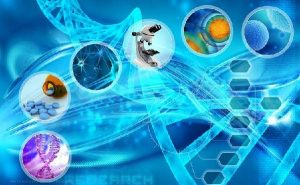
Academic Writing, Editing, Proofreading, And Problem Solving Services
Get 10% off with 24start discount code, 1. animal breeding: genetic methods.
Modern animal breeding relies on scientific methods to control production of domesticated animals, both livestock and pets, which exhibit desired physical and behavioral traits. Genetic technology aids animal breeders to attain nutritional, medical, recreational, and fashion standards demanded by consumers for animal products including meat, milk, eggs, leather, wool, and pharmaceuticals. Animals are also genetically designed to meet labor and sporting requirements for speed and endurance, conformation and beauty ideals to win show competitions, and intelligence levels to perform obediently at tasks such as herding, hunting, and tracking. By the late twentieth century, genetics and mathematical models were appropriated to identify the potential of immature animals. DNA markers indicate how young animals will mature, saving breeders money by not investing in animals lacking genetic promise. Scientists also successfully transplanted sperm-producing stem cells with the goal of restoring fertility to barren breeding animals. At the National Animal Disease Center in Ames, Iowa, researchers created a gene-based test, which uses a cloned gene of the organism that causes Johne’s disease in cattle in order to detect that disease to avert epidemics. Researchers also began mapping the dog genome and developing molecular techniques to evaluate canine chromosomes in the Quantitative Trait Loci (QTL). Bioinformatics incorporates computers to analyze genetic material. Some tests were developed to diagnose many of several hundred genetic canine diseases including hip dysplasia and progressive retinal atrophy (PRA). A few breed organizations modified standards to discourage breeding of genetically flawed animals and promote heterozygosity.
2. Antibacterial Chemotherapy
In the early years of the twentieth century, the search for agents that would be effective against internal infections proceeded along two main routes. The first was a search for naturally occurring substances that were effective against microorganisms (antibiosis). The second was a search for chemicals that would have the same effect (chemotherapy). Despite the success of penicillin in the 1940s, the major early advances in the treatment of infection occurred not through antibiosis but through chemotherapy. The principle behind chemotherapy was that there was a relationship between chemical structure and pharmacological action. The founder of this concept was Paul Erhlich (1854–1915). An early success came in 1905 when atoxyl (an organic arsenic compound) was shown to destroy trypanosomes, the microbes that caused sleeping sickness. Unfortunately, atoxyl also damaged the optic nerve. Subsequently, Erhlich and his co-workers synthesized and tested hundreds of related arsenic compounds. Ehrlich was a co-recipient (with Ilya Ilyich Mechnikov) of the Nobel Prize in medicine in 1908 for his work on immunity. Success in discovering a range of effective antibacterial drugs had three important consequences: it brought a range of important diseases under control for the first time; it provided a tremendous stimulus to research workers and opened up new avenues of research; and in the resulting commercial optimism, it led to heavy postwar investment in the pharmaceutical industry. The therapeutic revolution had begun.
3. Artificial Insemination and in Vitro Fertilization
Artificial insemination (AI) involves the extraction and collection of semen together with techniques for depositing semen in the uterus in order to achieve successful fertilization and pregnancy. Throughout the twentieth century, the approach has offered animal breeders the advantage of being able to utilize the best available breeding stock and at the correct time within the female reproductive cycle, but without the limitations of having the animals in the same location. AI has been applied most intensively within the dairy and beef cattle industries and to a lesser extent horse breeding and numerous other domesticated species.
Many of the techniques involved in artificial insemination would lay the foundation for in vitro fertilization (IVF) in the latter half of the twentieth century. IVF refers to the group of technologies that allow fertilization to take place outside the body involving the retrieval of ova or eggs from the female and sperm from the male, which are then combined in artificial, or ‘‘test tube,’’ conditions leading to fertilization. The fertilized eggs then continue to develop for several days ‘‘in culture’’ until being transferred to the female recipient to continue developing within the uterus.
4. Biopolymers
Biopolymers are natural polymers, long-chained molecules (macromolecules) consisting mostly of a repeated composition of building blocks or monomers that are formed and utilized by living organisms. Each group of biopolymers is composed of different building blocks, for example chains of sugar molecules form starch (a polysaccharide), chains of amino acids form proteins and peptides, and chains of nucleic acid form DNA and RNA (polynucleotides). Biopolymers can form gels, fibers, coatings, and films depending on the specific polymer, and serve a variety of critical functions for cells and organisms. Proteins including collagens, keratins, silks, tubulins, and actin usually form structural composites or scaffolding, or protective materials in biological systems (e.g., spider silk). Polysaccharides function in molecular recognition at cell membrane surfaces, form capsular barrier layers around cells, act as emulsifiers and adhesives, and serve as skeletal or architectural materials in plants. In many cases these polymers occur in combination with proteins to form novel composite structures such as invertebrate exoskeletons or microbial cell walls, or with lignin in the case of plant cell walls.
The use of the word ‘‘cloning’’ is fraught with confusion and inconsistency, and it is important at the outset of this discussion to offer definitional clarification. For instance, in the 1997 article by Ian Wilmut and colleagues announcing the birth of the first cloned adult vertebrate (a ewe, Dolly the sheep) from somatic cell nuclear transfer, the word clone or cloning was never used, and yet the announcement raised considerable disquiet about the prospect of cloned human beings. In a desire to avoid potentially negative forms of language, many prefer to substitute ‘‘cell expansion techniques’’ or ‘‘therapeutic cloning’’ for cloning. Cloning has been known for centuries as a horticultural propagation method: for example, plants multiplied by grafting, budding, or cuttings do not differ genetically from the original plant. The term clone entered more common usage as a result of a speech in 1963 by J.B.S. Haldane based on his paper, ‘‘Biological possibilities for the human species of the next ten-thousand years.’’ Notwithstanding these notes of caution, we can refer to a number of processes as cloning. At the close of the twentieth century, such techniques had not yet progressed to the ability to bring a cloned human to full development; however, the ability to clone cells from an adult human has potential to treat diseases. International policymaking in the late 1990s sought to distinguish between the different end uses for somatic cell nuclear transfer resulting in the widespread adoption of the distinction between ‘‘reproductive’’ and ‘‘therapeutic’’ cloning. The function of the distinction has been to permit the use (in some countries) of the technique to generate potentially beneficial therapeutic applications from embryonic stem cell technology whilst prohibiting its use in human reproduction. In therapeutic applications, nuclear transfer from a patient’s cells into an enucleated ovum is used to create genetically identical embryos that would be grown in vitro but not be allowed to continue developing to become a human being. The resulting cloned embryos could be used as a source from which to produce stem cells that can then be induced to specialize into the specific type of tissue required by the patient (such as skin for burns victims, brain neuron cells for Parkinson’s disease sufferers, or pancreatic cells for diabetics). The rationale is that because the original nuclear material is derived from a patient’s adult tissue, the risks of rejection of such cells by the immune system are reduced.
6. Gene Therapy
In 1971, Australian Nobel laureate Sir F. MacFarlane Burnet thought that gene therapy (introducing genes into body tissue, usually to treat an inherited genetic disorder) looked more and more like a case of the emperor’s new clothes. Ethical issues aside, he believed that practical considerations forestalled possibilities for any beneficial gene strategy, then or probably ever. Bluntly, he wrote: ‘‘little further advance can be expected from laboratory science in the handling of ‘intrinsic’ types of disability and disease.’’ Joshua Lederberg and Edward Tatum, 1958 Nobel laureates, theorized in the 1960s that genes might be altered or replaced using viral vectors to treat human diseases. Stanfield Rogers, working from the Oak Ridge National Laboratory in 1970, had tried but failed to cure argininemia (a genetic disorder of the urea cycle that causes neurological damage in the form of mental retardation, seizures, and eventually death) in two German girls using Swope papilloma virus. Martin Cline at the University of California in Los Angeles, made the second failed attempt a decade later. He tried to correct the bone marrow cells of two beta-thalassemia patients, one in Israel and the other in Italy. What Cline’s failure revealed, however, was that many researchers who condemned his trial as unethical were by then working toward similar goals and targeting different diseases with various delivery methods. While Burnet’s pessimism finally proved to be wrong, progress in gene therapy was much slower than antibiotic or anticancer chemotherapy developments over the same period of time. While gene therapy had limited success, it nevertheless remained an active area for research, particularly because the Human Genome Project, begun in 1990, had resulted in a ‘‘rough draft’’ of all human genes by 2001, and was completed in 2003. Gene mapping created the means for analyzing the expression patterns of hundreds of genes involved in biological pathways and for identifying single nucleotide polymorphisms (SNPs) that have diagnostic and therapeutic potential for treating specific diseases in individuals. In the future, gene therapies may prove effective at protecting patients from adverse drug reactions or changing the biochemical nature of a person’s disease. They may also target blood vessel formation in order to prevent heart disease or blindness due to macular degeneration or diabetic retinopathy. One of the oldest ideas for use of gene therapy is to produce anticancer vaccines. One method involves inserting a granulocyte-macrophage colony-stimulating factor gene into prostate tumor cells removed in surgery. The cells then are irradiated to prevent any further cancer and injected back into the same patient to initiate an immune response against any remaining metastases. Whether or not such developments become a major treatment modality, no one now believes, as MacFarland Burnet did in 1970, that gene therapy science has reached an end in its potential to advance health.
7. Genetic Engineering
The term ‘‘genetic engineering’’ describes molecular biology techniques that allow geneticists to analyze and manipulate deoxyribonucleic acid (DNA). At the close of the twentieth century, genetic engineering promised to revolutionize many industries, including microbial biotechnology, agriculture, and medicine. It also sparked controversy over potential health and ecological hazards due to the unprecedented ability to bypass traditional biological reproduction.
For centuries, if not millennia, techniques have been employed to alter the genetic characteristics of animals and plants to enhance specifically desired traits. In a great many cases, breeds with which we are most familiar bear little resemblance to the wild varieties from which they are derived. Canine breeds, for instance, have been selectively tailored to changing esthetic tastes over many years, altering their appearance, behavior and temperament. Many of the species used in farming reflect long-term alterations to enhance meat, milk, and fleece yields. Likewise, in the case of agricultural varieties, hybridization and selective breeding have resulted in crops that are adapted to specific production conditions and regional demands. Genetic engineering differs from these traditional methods of plant and animal breeding in some very important respects. First, genes from one organism can be extracted and recombined with those of another (using recombinant DNA, or rDNA, technology) without either organism having to be of the same species. Second, removing the requirement for species reproductive compatibility, new genetic combinations can be produced in a much more highly accelerated way than before. Since the development of the first rDNA organism by Stanley Cohen and Herbert Boyer in 1973, a number of techniques have been found to produce highly novel products derived from transgenic plants and animals.
At the same time, there has been an ongoing and ferocious political debate over the environmental and health risks to humans of genetically altered species. The rise of genetic engineering may be characterized by developments during the last three decades of the twentieth century.
8. Genetic Screening and Testing
The menu of genetic screening and testing technologies now available in most developed countries increased rapidly in the closing years of the twentieth century. These technologies emerged within the context of rapidly changing social and legal contexts with regard to the medicalization of pregnancy and birth and the legalization of abortion. The earliest genetic screening tests detected inborn errors of metabolism and sex-linked disorders. Technological innovations in genomic mapping and DNA sequencing, together with an explosion in research on the genetic basis of disease which culminated in the Human Genome Project (HGP), led to a range of genetic screening and testing for diseases traditionally recognized as genetic in origin and for susceptibility to more common diseases such as certain types of familial cancer, cardiac conditions, and neurological disorders among others. Tests were also useful for forensic, or nonmedical, purposes. Genetic screening techniques are now available in conjunction with in vitro fertilization and other types of reproductive technologies, allowing the screening of fertilized embryos for certain genetic mutations before selection for implantation. At present selection is purely on disease grounds and selection for other traits (e.g., for eye or hair color, intelligence, height) cannot yet be done, though there are concerns for eugenics and ‘‘designer babies.’’ Screening is available for an increasing number of metabolic diseases through tandem mass spectrometry, which uses less blood per test, allows testing for many conditions simultaneously, and has a very low false-positive rate as compared to conventional Guthrie testing. Finally, genetic technologies are being used in the judicial domain for determination of paternity, often associated with child support claims, and for forensic purposes in cases where DNA material is available for testing.
9. Plant Breeding: Genetic Methods
The cultivation of plants is the world’s oldest biotechnology. We have continually tried to produce improved varieties while increasing yield, features to aid cultivation and harvesting, disease, and pest resistance, or crop qualities such as longer postharvest storage life and improved taste or nutritional value. Early changes resulted from random crosspollination, rudimentary grafting, or spontaneous genetic change. For centuries, man kept the seed from the plants with improved characteristics to plant the following season’s crop. The pioneering work of Gregor Mendel and his development of the basic laws of heredity showed for other first time that some of the processes of heredity could be altered by experimental means. The genetic analysis of bacterial (prokaryote) genes and techniques for analysis of the higher (eukaryotic) organisms such as plants developed in parallel streams, but the rediscovery of Mendel’s work in 1900 fueled a burst of activity on understanding the role of genes in inheritance. The knowledge that genes are linked along the chromosome thereby allowed mapping of genes (transduction analysis, conjugation analysis, and transformation analysis). The power of genetics to produce a desirable plant was established, and it was appreciated that controlled breeding (test crosses and back crosses) and careful analysis of the progeny could distinguish traits that were dominant or recessive, and establish pure breeding lines. Traditional horticultural techniques of artificial self-pollination and cross-pollination were also used to produce hybrids. In the 1930s the Russian Nikolai Vavilov recognized the value of genetic diversity in domesticated crop plants and their wild relatives to crop improvement, and collected seeds from the wild to study total genetic diversity and use these in breeding programs. The impact of scientific crop breeding was established by the ‘‘Green revolution’’ of the 1960s, when new wheat varieties with higher yields were developed by careful crop breeding. ‘‘Mutation breeding’’— inducing mutations by exposing seeds to x-rays or chemicals such as sodium azide, accelerated after World War II. It was also discovered that plant cells and tissues grown in tissue culture would mutate rapidly. In the 1970s, haploid breeding, which involves producing plants from two identical sets of chromosomes, was extensively used to create new cultivars. In the twenty-first century, haploid breeding could speed up plant breeding by shortening the breeding cycle.
10. Tissue Culturing
The technique of tissue or cell culture, which relates to the growth of tissue or cells within a laboratory setting, underlies a phenomenal proportion of biomedical research. Though it has roots in the late nineteenth century, when numerous scientists tried to grow samples in alien environments, cell culture is credited as truly beginning with the first concrete evidence of successful growth in vitro, demonstrated by Johns Hopkins University embryologist Ross Harrison in 1907. Harrison took sections of spinal cord from a frog embryo, placed them on a glass cover slip and bathed the tissue in a nutrient media. The results of the experiment were startling—for the first time scientists visualized actual nerve growth as it would happen in a living organism—and many other scientists across the U.S. and Europe took up culture techniques. Rather unwittingly, for he was merely trying to settle a professional dispute regarding the origin of nerve fibers, Harrison fashioned a research tool that has since been designated by many as the greatest advance in medical science since the invention of the microscope.
From the 1980s, cell culture has once again been brought to the forefront of cancer research in the isolation and identification of numerous cancer causing oncogenes. In addition, cell culturing continues to play a crucial role in fields such as cytology, embryology, radiology, and molecular genetics. In the future, its relevance to direct clinical treatment might be further increased by the growth in culture of stem cells and tissue replacement therapies that can be tailored for a particular individual. Indeed, as cell culture approaches its centenary, it appears that its importance to scientific, medical, and commercial research the world over will only increase in the twenty-first century.
History of Biotechnology
Biotechnology grew out of the technology of fermentation, which was called zymotechnology. This was different from the ancient craft of brewing because of its thought-out relationships to science. These were most famously conceptualized by the Prussian chemist Georg Ernst Stahl (1659–1734) in his 1697 treatise Zymotechnia Fundamentalis, in which he introduced the term zymotechnology. Carl Balling, long-serving professor in Prague, the world center of brewing, drew on the work of Stahl when he published his Bericht uber die Fortschritte der zymotechnische Wissenschaften und Gewerbe (Account of the Progress of the Zymotechnic Sciences and Arts) in the mid-nineteenth century. He used the idea of zymotechnics to compete with his German contemporary Justus Liebig for whom chemistry was the underpinning of all processes.
By the end of the nineteenth century, there were attempts to develop a new scientific study of fermentation. It was an aspect of the ‘‘second’’ Industrial Revolution during the period from 1870 to 1914. The emergence of the chemical industry is widely taken as emblematic of the formal research and development taking place at the time. The development of microbiological industries is another example. For the first time, Louis Pasteur’s germ theory made it possible to provide convincing explanations of brewing and other fermentation processes.
Pasteur had published on brewing in the wake of France’s humiliation in the Franco–Prussian war (1870–1871) to assert his country’s superiority in an industry traditionally associated with Germany. Yet the science and technology of fermentation had a wide range of applications including the manufacture of foods (cheese, yogurt, wine, vinegar, and tea), of commodities (tobacco and leather), and of chemicals (lactic acid, citric acid, and the enzyme takaminase). The concept of zymotechnology associated principally with the brewing of beer began to appear too limited to its principal exponents. At the time, Denmark was the world leader in creating high-value agricultural produce. Cooperative farms pioneered intensive pig fattening as well as the mass production of bacon, butter, and beer. It was here that the systems of science and technology were integrated and reintegrated, conceptualized and reconceptualized.
The Dane Emil Christian Hansen discovered that infection from wild yeasts was responsible for numerous failed brews. His contemporary Alfred Jørgensen, a Copenhagen consultant closely associated with the Tuborg brewery, published a widely used textbook on zymotechnology. Microorganisms and Fermentation first appeared in Danish 1889 and would be translated, reedited, and reissued for the next 60 years.
The scarcity of resources on both sides during World War I brought together science and technology, further development of zymotechnology, and formulation of the concept of biotechnology. Impending and then actual war accelerated the use of fermentation technologies to make strategic materials. In Britain a variant of a process to ferment starch to make butadiene for synthetic rubber production was adapted to make acetone needed in the manufacture of explosives. The process was technically important as the first industrial sterile fermentation and was strategically important for munitions supplies. The developer, chemist Chaim Weizmann, later became well known as the first president of Israel in 1949.
In Germany scarce oil-based lubricants were replaced by glycerol made by fermentation. Animal feed was derived from yeast grown with the aid of the new synthetic ammonia in another wartime development that inspired the coining of the word biotechnology. Hungary was the agricultural base of the Austro–Hungarian empire and aspired to Danish levels of efficiency. The economist Karl Ereky (1878–1952) planned to go further and build the largest industrial pig-processing factory. He envisioned a site that would fatten 50,000 swine at a time while railroad cars of sugar beet arrived and fat, hides, and meat departed. In this forerunner of the Soviet collective farm, peasants (in any case now falling prey to the temptations of urban society) would be completely superseded by the industrialization of the biological process in large factory-like animal processing units. Ereky went further in his ruminations over the meaning of his innovation. He suggested that it presaged an industrial revolution that would follow the transformation of chemical technology. In his book entitled Biotechnologie, he linked specific technical injunctions to wide-ranging philosophy. Ereky was neither isolated nor obscure. He had been trained in the mainstream of reflection on the meaning of the applied sciences in Hungary, which would be remarkably productive across the sciences. After World War I, Ereky served as Hungary’s minister of food in the short-lived right wing regime that succeeded the fall of the communist government of Bela Kun.
Nonetheless it was not through Ereky’s direct action that his ideas seem to have spread. Rather, his book was reviewed by the influential Paul Lindner, head of botany at the Institut fu¨ r Ga¨ rungsgewerbe in Berlin, who suggested that microorganisms could also be seen as biotechnological machines. This concept was already found in the production of yeast and in Weizmann’s work with strategic materials, which was widely publicized at that very time. It was with this meaning that the word ‘‘Biotechnologie’’ entered German dictionaries in the 1920s.
Biotechnology represented more than the manipulation of existing organisms. From the beginning it was concerned with their improvement as well, and this meant the enhancement of all living creatures. Most dramatically this would include humanity itself; more mundanely it would include plants and animals of agricultural importance. The enhancement of people was called eugenics by the Victorian polymath and cousin of Charles Darwin, Francis Galton. Two strains of eugenics emerged: negative eugenics associated with weeding out the weak and positive eugenics associated with enhancing strength. In the early twentieth century, many eugenics proponents believed that the weak could be made strong. People had after all progressed beyond their biological limits by means of technology.
Jean-Jacques Virey, a follower of the French naturalist Jean-Baptiste de Monet de Lamarck, had coined the term ‘‘biotechnie’’ in 1828 to describe man’s ability to make technology do the work of biology, but it was not till a century later that the term entered widespread use. The Scottish biologist and town planner Patrick Geddes made biotechnics popular in the English-speaking world. Geddes, too, sought to link life and technology. Before World War I he had characterized the technological evolution of mankind as a move from the paleotechnic era of coal and iron to the neotechnic era of chemicals, electricity, and steel. After the war, he detected a new era based on biology—the biotechnic era. Through his friend, writer Lewis Mumford, Geddes would have great influence. Mumford’s book Technics and Civilization, itself a founding volume of the modern historiography of technology, promoted his vision of the Geddesian evolution.
A younger generation of English experimental biologists with a special interest in genetics, including J. B. S. Haldane, Julian Huxley, and Lancelot Hogben, also promoted a concept of biotechnology in the period between the world wars. Because they wrote popular works, they were among Britain’s best-known scientists. Haldane wrote about biological invention in his far-seeing work Daedalus. Huxley looked forward to a blend of social and eugenics-based biological engineering. Hogben, following Geddes, was more interested in engineering plants through breeding. He tied the progressivism of biology to the advance of socialism.
The improvement of the human race, genetic manipulation of bacteria, and the development of fermentation technology were brought together by the development of penicillin during World War II. This drug was successfully extracted from the juice exuded by a strain of the Penicillium fungus. Although discovered by accident and then developed further for purely scientific reasons, the scarce and unstable ‘‘antibiotic’’ called penicillin was transformed during World War II into a powerful and widely used drug. Large networks of academic and government laboratories and pharmaceutical manufacturers in Britain and the U.S. were coordinated by agencies of the two governments. An unanticipated combination of genetics, biochemistry, chemistry, and chemical engineering skills had been required. When the natural mold was bombarded with high-frequency radiation, far more productive mutants were produced, and subsequently all the medicine was made using the product of these man-made cells. By the 1950s penicillin was cheap to produce and globally available.
The new technology of cultivating and processing large quantities of microorganisms led to calls for a new scientific discipline. Biochemical engineering was one term, and applied microbiology another. The Swedish biologist, Carl-Goran Heden, possibly influenced by German precedents, favored the term ‘‘Biotechnologi’’ and persuaded his friend Elmer Gaden to relabel his new journal Biotechnology and Biochemical Engineering. From 1962 major international conferences were held under the banner of the Global Impact of Applied Microbiology. During the 1960s food based on single-cell protein grown in fermenters on oil or glucose seemed, to visionary engineers and microbiologists and to major companies, to offer an immediate solution to world hunger. Tropical countries rich in biomass that could be used as raw material for fermentation were also the world’s poorest. Alcohol could be manufactured by fermenting such starch or sugar rich crops as sugar cane and corn. Brazil introduced a national program of replacing oil-based petrol with alcohol in the 1970s.
It was not, however, just the developing countries that hoped to benefit. The Soviet Union developed fermentation-based protein as a major source of animal feed through the 1980s. In the U.S. it seemed that oil from surplus corn would solve the problem of low farm prices aggravated by the country’s boycott of the USSR in1979, and the term ‘‘gasohol‘‘ came into currency. Above all, the decline of established industries made the discovery of a new wealth maker an urgent priority for Western governments. Policy makers in both Germany and Japan during the 1970s were driven by a sense of the inadequacy of the last generation of technologies. These were apparently maturing, and the succession was far from clear. Even if electronics or space travel offered routes to the bright industrial future, these fields seemed to be dominated by the U.S. Seeing incipient crisis, the Green, or environmental, movement promoted a technology that would depend on renewable resources and on low-energy processes that would produce biodegradable products, recycle waste, and address problems of the health and nutrition of the world.
In 1973 the German government, seeking a new and ‘‘greener’’ industrial policy, commissioned a report entitled Biotechnologie that identified ways in which biological processing was key to modern developments in technology. Even though the report was published at the time that recombinant DNA (deoxyribonucleic acid) was becoming possible, it did not refer to this new technique and instead focused on the use and combination of existing technologies to make novel products.
Nonetheless the hitherto esoteric science of molecular biology was making considerable progress, although its practice in the early 1970s was rather distant from the world of industrial production. The phrase ‘‘genetic engineering’’ entered common parlance in the 1960s to describe human genetic modification. Medicine, however, put a premium on the use of proteins that were difficult to extract from people: insulin for diabetics and interferon for cancer sufferers. During the early 1970s what had been science fiction became fact as the use of DNA synthesis, restriction enzymes, and plasmids were integrated. In 1973 Stanley Cohen and Herbert Boyer successfully transferred a section of DNA from one E. coli bacterium to another. A few prophets such as Joshua Lederberg and Walter Gilbert argued that the new biological techniques of recombinant DNA might be ideal for making synthetic versions of expensive proteins such as insulin and interferon through their expression in bacterial cells. Small companies, such as Cetus and Genentech in California and Biogen in Cambridge, Massachusetts, were established to develop the techniques. In many cases discoveries made by small ‘‘boutique’’ companies were developed for the market by large, more established, pharmaceutical organizations.
Many governments were impressed by these advances in molecular genetics, which seemed to make biotechnology a potential counterpart to information technology in a third industrial revolution. These inspired hopes of industrial production of proteins identical to those produced in the human body that could be used to treat genetic diseases. There was also hope that industrially useful materials such as alcohol, plastics (biopolymers), or ready-colored fibers might be made in plants, and thus the attractions of a potentially new agricultural era might be as great as the implications for medicine. At a time of concern over low agricultural prices, such hopes were doubly welcome. Indeed, the agricultural benefits sometimes overshadowed the medical implications.
The mechanism for the transfer of enthusiasm from engineering fermenters to engineering genes was the New York Stock Exchange. At the end of the 1970s, new tax laws encouraged already adventurous U.S. investors to put money into small companies whose stock value might grow faster than their profits. The brokerage firm E. F. Hutton saw the potential for the new molecular biology companies such as Biogen and Cetus. Stock market interest in companies promising to make new biological entities was spurred by the 1980 decision of the U.S. Supreme Court to permit the patenting of a new organism. The patent was awarded to the Exxon researcher Ananda Chakrabarty for an organism that metabolized hydrocarbon waste. This event signaled the commercial potential of biotechnology to business and governments around the world. By the early 1980s there were widespread hopes that the protein interferon, made with some novel organism, would provide a cure for cancer. The development of monoclonal antibody technology that grew out of the work of Georges J. F. Kohler and Cesar Milstein in Cambridge (co-recipients with Niels K. Jerne of the Nobel Prize in medicine in 1986) seemed to offer new prospects for precise attacks on particular cells.
The fear of excessive regulatory controls encouraged business and scientific leaders to express optimistic projections about the potential of biotechnology. The early days of biotechnology were fired by hopes of medical products and high-value pharmaceuticals. Human insulin and interferon were early products, and a second generation included the anti-blood clotting agent tPA and the antianemia drug erythropoietin. Biotechnology was also used to help identify potential new drugs that might be made chemically, or synthetically.
At the same time agricultural products were also being developed. Three early products that each raised substantial problems were bacteria which inhibited the formation of frost on the leaves of strawberry plants (ice-minus bacteria), genetically modified plants including tomatoes and rapeseed, and the hormone bovine somatrotropin (BST) produced in genetically modified bacteria and administered to cattle in the U.S. to increase milk yields. By 1999 half the soy beans and one third of the corn grown in the U.S. were modified. Although the global spread of such products would arouse the best known concern at the end of the century, the use of the ice-minus bacteria— the first authorized release of a genetically engineered organism into the environment—had previously raised anxiety in the U.S. in the 1980s.
In 1997 Dolly the sheep was cloned from an adult mother in the Roslin agricultural research institute outside Edinburgh, Scotland. This work was inspired by the need to find a way of reproducing sheep engineered to express human proteins in their milk. However, the public interest was not so much in the cloning of sheep that had just been achieved as in the cloning of people, which had not. As in the Middle Ages when deformed creatures had been seen as monsters and portents of natural disasters, Dolly was similarly seen as monster and as a portent of human cloning.
The name Frankenstein, recalled from the story written by Mary Shelley at the beginning of the nineteenth century and from the movies of the 1930s, was once again familiar at the end of the twentieth century. Shelley had written in the shadow of Stahl’s theories. The continued appeal of this book embodies the continuity of the fears of artificial life and the anxiety over hubris. To this has been linked a more mundane suspicion of the blending of commerce and the exploitation of life. Discussion of biotechnology at the end of the twentieth century was therefore colored by questions of whose assurances of good intent and reassurance of safety could be trusted.
Browse other Technology Research Paper Topics .
ORDER HIGH QUALITY CUSTOM PAPER

Scientist’s RIT experience leads to career in revolutionary gene therapy research
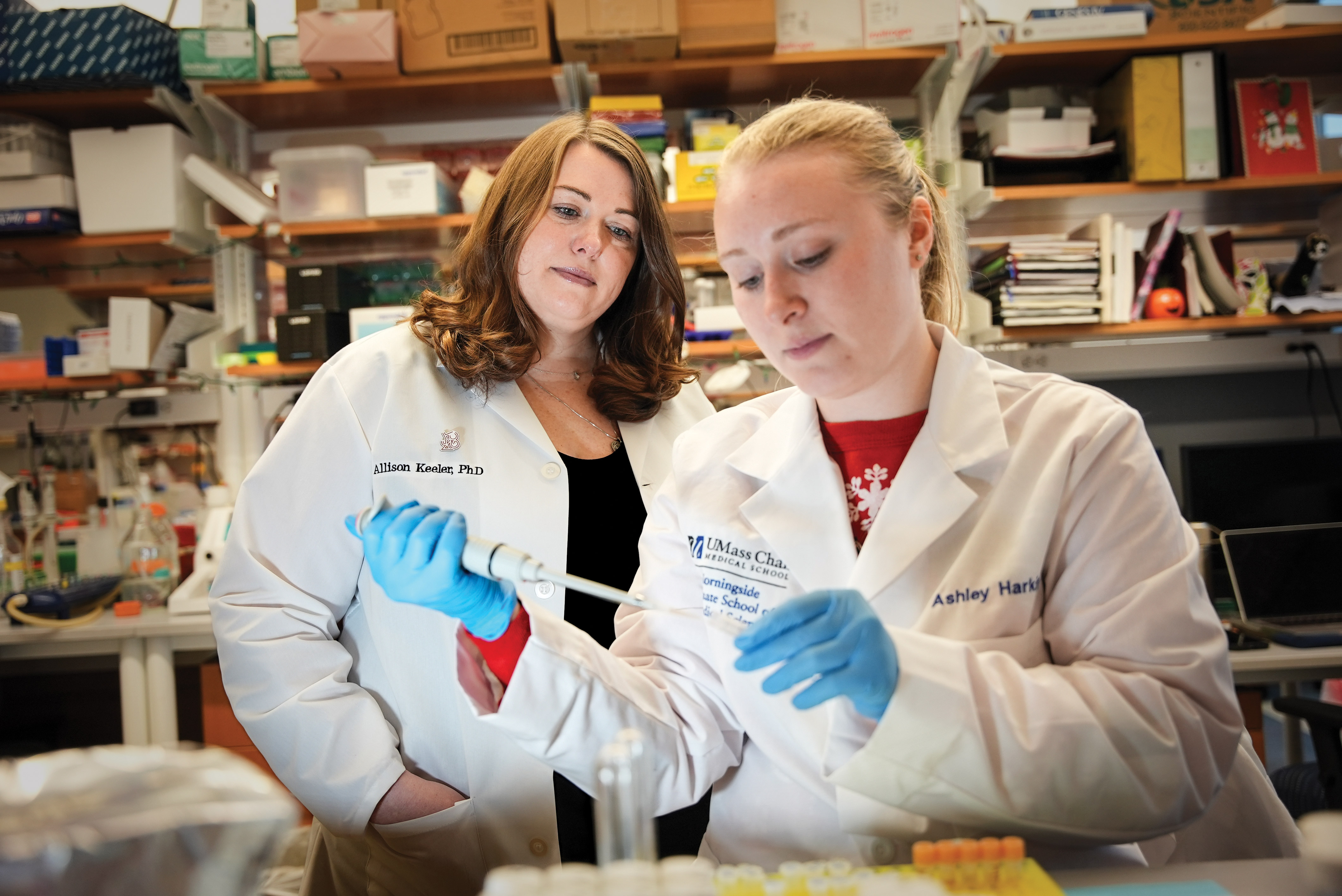
Bryan Goodchild
Allison Keeler ’05 (biotechnology), left, has turned her lifelong interest in science into a career in medical research. She is the lead researcher in the Keeler Lab at the Horae Gene Therapy Center and assistant professor at the University of Massachusetts Chan Medical School.
From an early age, Allison Keeler ’05 ( biotechnology ) always knew she wanted to be a scientist. As an adult, that dream has come true as she is an assistant professor in the Department of Pediatrics at the University of Massachusetts (UMass) Chan Medical School and the lead researcher in the Keeler Lab within the Horae Gene Therapy Center .
Keeler applied early to RIT, out of her high school in eastern Pennsylvania. After visiting the campus and learning the university had one of the few biotechnology programs available, she knew getting hands-on experience in research at RIT was the best path for her future.
Keeler earned her bachelor’s degree in three years and was able to take advantage of a trip to the Galápagos Islands, where she realized she wanted to become an academic and a professor. After a research position at Duke University, she earned her Ph.D. in biomedical sciences from the UMass Medical School, where she now works. Mentoring and teaching in a lab environment has become her passion.
“Basics that I learned at RIT and each of my experiences have shaped where I am now and what I’m really passionate about,” said Keeler.
Her background has led her to one of the most revolutionary medical fields today: gene therapy. This technology approaches disease differently, by attempting to change genetic makeups to prevent and treat disease instead of traditional treatments like medication and surgery.
In her lab, Keeler is learning about and understanding immune responses to gene therapy and engineering and developing new novel gene therapies for the treatment of different diseases.
The field is progressing rapidly. When she was a graduate student, there were no approved therapies. Now, there are many, with more being approved every year.
“It’s been really interesting to watch the field evolve,” said Keeler. “It’s an exciting time in this field because several gene therapies have recently been approved.”
The scientific area is familiar to the dean of RIT’s College of Science , André Hudson , who is repeatedly sought out as an expert in biochemistry and microbiology. His research interests are closely related to Keeler’s, as both are excited about the future of science as it relates to the human body and disease.
“The work by Dr. Keeler and colleagues in this space is at the forefront of science and medicine,” said Hudson. “I am heartened that one of our College of Science alumni is helping to lead the charge.”
Keeler never envisioned she would be running her own gene therapy lab when she stepped on RIT’s campus as a biotechnology major. But as science grows and evolves, more and more possibilities for careers in science exist. She encourages students to keep their minds open and to explore all opportunities.
“I didn’t even know about gene therapy when I was at RIT,” said Keeler. “But science continues to expand. Keep being curious, keep asking questions.”
Recommended News
April 27, 2024
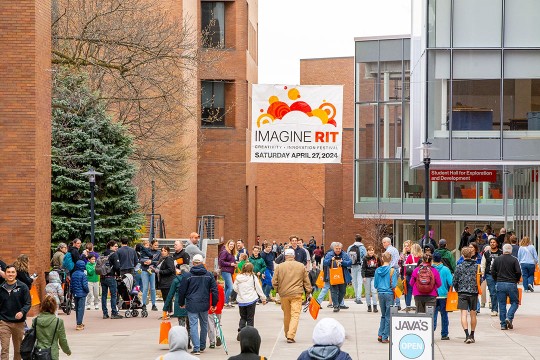
Innovation meets creativity at Imagine RIT
Artificial intelligence, robots, glass blowing, virtual reality, and performing arts were just a sampling of what thousands of visitors experienced at the 2024 Imagine RIT: Creativity and Innovation Festival on April 27.
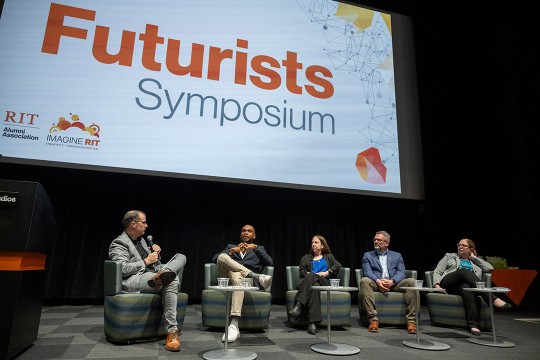
University’s ‘futurists’ encourage audience to embrace curiosity during Imagine RIT symposium
Be curious because what if, said RIT alumnus Bob Morrealle, who shared stories of discovery, hope, and confidence during his presentation at the Futurists Symposium, a collection of alumni and faculty offering an insider’s look into the future of technology, the arts, and design. The symposium, held April 26 in the Wegmans Theater, MAGIC Spell Studios, was the official kickoff to Imagine RIT: Creativity and Innovation Festival.
April 26, 2024

Color Chat: Disney’s Image and Color Engineer Molly Hill
postPerspective talks to Molly Hill '18 (motion picture science), '18 (film and animation), about her experience working as a senior image and color engineer at The Walt Disney Studios.

Showcasing creativity and innovation at Imagine RIT
13WHAM/Fox Rochester previews Imagine RIT in eight segments.
- Privacy Policy
Biotechnology Research Topics
What is biotechnology.
What first pops up in your mind when you hear the term Biotechnology? Maybe you started thinking of GMOs ( Genetically Modified Organisms ), transgenic cloning, and other gene therapies. Of course, you got it right, but the horizon of biotechnology is not so tiny. It has a wide range of applications in the industry that can improve our living standards. Let us first understand the term Biotechnology. In simple words, it is the utilization of living organisms or their components in the industrial sector to generate various products that are beneficial for the human race. We have been utilizing microorganisms for more than thousands of years to develop useful commodities such as cheese, bread, and various other dairy-related products. Even its implementation in the medical sector has led to the manufacturing of different vaccines, biofuel, chitosan-coated dressing for wounds, brewing, and even age-defying products. As the biotechnology scope is expanding day by day, researchers felt an urge to classify main areas and types of biotechnology depending on some commonalities and their ultimate objectives:
Red Biotechnology- involves the utilization of organisms for upgrading the quality of health care departments and aiding the body’s immune system to fight against various diseases. Examples include; the development of different vaccines, antibiotics, medicinal drugs, and various molecular techniques.
White Biotechnology- mainly comprises industrial biotechnology and involves the utilization of microorganisms and their by-products for manufacturing more eco-friendly and energy-efficient products. White biotechnology examples include the production of biofuel, Lactic acid, and 3- hydroxy propionic acid.
Yellow Biotechnology- it is related to the use of Biotech in the food production area, i.e., making bread, cheese, beer, and wine by the fermentation process.
Grey Biotechnology – mainly deals with the removal of pollutants from the environment by using various microorganisms and plants. For example., different strains of bacteria can be used for the degradation of kitchen waste into compost.
Green Biotechnology- concentrates on the agriculture sector and focuses on generating new varieties of plants and producing good quality bio-pesticides & bio-fertilizers.
Blue Biotechnology – it mainly refers to the utilization of aquatic or marine organisms to create goods that can aid various industrial processes, such as using Chitosan (sugar derived from the shells of crabs and shrimps) for the dressing of wounds.
Biotechnology Topics for Research Paper
In the modern world, students are apprehending the benefits of Biotech and want to study it with more enthusiasm and interest. They are actively opting for this subject and compiling their research work to contribute their efforts in the field of Biotechnology. They are indulged in exhaustive research to find the best topic for the research purpose. So, here are a few potential research topics in the domain of Biotechnology:
Red Biotechnology Research Topics:
- Studying the relationship between the intake of iron-folic acid during pregnancy and its impact on the overall health of the fetus.
- Pharmacogenomics of antimicrobial drugs.
- Identifying the biomarkers linked with breast cancer.
- Study the medicinal value of natural antioxidants.
- Study the structure of coronavirus spike proteins.
- Studying the immune response of stem cell therapy.
- Utilization of CRISPR-Cas9 technology for genome editing.
- Application of Chitosan in tissue engineering and drug delivery.
- Study the therapeutic effects of cancer vaccines.
- Utilizing PacBio sequencing for the genome assembly of model organisms.
- Study the relationship between the suppression of mRNA and its effect on stem cell expansion.
- Study the application of nanoprobes in molecular imaging.
- Incorporating biomimicry for the detection of tumor cells.
- Study of immune-based therapies in treating COVID-19.
- Regulation of immune response using the cellular and molecular mechanism
- Microchip implantation – a vaccine for coronavirus.
- The Use of CRISPR for Human Genome Editing
Yellow Biotechnology Research Topics:
- Production of hypoallergenic milk.
- Production of hypoallergenic fermented foods.
- Yellow enzymes subclassification and their characterization.
White Biotechnology Research Topics:
- Bioconversion of cellulose to yield industrially important products.
- Studying the inhibitors of endocellulase and exocellulase.
- Fungal enzymes used in the production of chemical glue.
- Mechanism of fungal enzymes in the biodegradation of lignin.
- Studying gut microbiota in model organisms.
- Study the lactic acid bacteria for probiotic potential.
- Purification of thermostable phytase.
- Mesophilic and Thermophilic aerobic and anaerobic bacteria from compost.
- Study the dietary strategies for the prophylaxis of Alzheimer’s and dementia.
- Examine the positive effects of probiotics and prebiotics on the nervous system.
Examples of Grey Biotechnology Research Topics:
- Production of sustainable, low-cost, and environmentally friendly microbial biocement and biogrouts.
- Use of microorganisms for the recovery of shale gas.
- Studying the procedure of natural decomposition.
- Treatment of grey water in a multilayer reactor with passive aeration.
- Excavation of various anaerobic microbes using grey biotechnology.
- Improving the biodegradation of micro-plastics using GMOs.
- Removal of pollutants from the land.
- Use of microbes to excavate the hidden metals from earth.
- Managing the processes of environmental biotechnology using microbial ecology.
- In situ product removal techniques using the process of biocatalysis.
- Production of biodegradable, disposable plastic for the storage of food.
- Plastic waste decomposition management.
- Maintaining a healthy equilibrium between biotic and abiotic factors using biotechnological tools.
- Recycling of biowastes.
- Restoration of biodiversity using tools.
- Improved Recombinant DNA technology for bioremediation.
- Gold biosorption using cyanobacterium.
- Improved bioremediation of oil spills.
- Biodegradation of oil and natural gas.
Blue Biotechnology Research Ideas:
- Various bioactive compounds derived from marine sponges.
- Controlling the emerged biological contaminant using the sustainable future.
- Protecting the environment using grey, blue, and green biotechnology.
- Exploring marine biota which survives the extreme conditions.
- Studying the patterns of Arctic and Antarctic microbiota for the benefits of humans.
- Excavation of bioactive molecules from extreme environmental conditions.
- Studying the potential of sponge-associated microbes.
- Mercury labeling in the fish using markers.
- Sea urchin repelling ocean macroalgal afforestation.
- Microbial detection techniques to find sea animals.
- Studying the mechanisms in deep-sea hydrothermal vent bacteria.
- Production of antibiotics using marine fungi.
- Exploring the biotechnological potential of Jellyfish associated microbiome.
- Exploring the potential of marine fungi in degrading plastics and polymers.
- Expl oring the biotechnological potential of dinoflagellates.
Green Biotechnology Research Paper Topics:
- Detection of endosulfan residues using biotechnology in agricultural products.
- Development of ELISA technique for the detection of crops’ viruses.
- Use of Green Fluorescent Protein (GFP) as a cytoplasmic folding reporter.
- E.coli as an all-rounder in biotechnological studies.
- Improving the water quality for drinking using E.coli consortium.
- E.coli characterization isolated from the zoo animals’ feces.
- Biocatalysis and agricultural biotechnology in situ studies.
- Improving the insect resistance of the crops.
- Improving the nutritional value and longer shelf life of GM crops.
- Improving the qualities of hydroponic GM plants.
- Reducing the cost of agriculture using bio-tools.
- Production of heavy cotton balls in agricultural biotechnology using in situ technique.
- Steps to minimize soil erosion using the tools of biotechnology.
- Enhancement of vitamin levels in GM Foods .
- Improving pesticide delivery using biotechnology.
- Comparison of folate biofortification of different crops.
- Photovoltaic-based production of crops in the ocean.
- Application of nanotechnology in the agricultural sector.
- Study the water stress tolerance mechanisms in model plants.
Combination and Analytical Topics:
- Sequencing of infectious microbes using molecular probes.
- Production and testing of human immune boosters in experimental organisms.
- Comparative genomic analysis using the tools of bioinformatics.
- Arabinogalactan protein sequencing using computational methods.
- Comparative analysis of different protein purification techniques.
- Oligonucleotide microarrays used in the diagnosis of the microbes.
- Uses of different techniques in biomedical research including microarray technology.
- Microbial consortium used to produce the greenhouse effect.
- Computational analysis of different proteins obtained from marine microbiota.
- Gene mapping of E.coli using different microbial tools.
- Computational analysis and characterization of the crystallized proteins in nature.
- Improving the strains of cyanobacterium using gene sequencing.
- mTERF protein used to terminate the mitochondrial DNA transcription in algae.
- Reverse phase column chromatography used to separate proteins.
- Study of different proteins present in Mycobacterium leprae.
- Study the strategies best suitable for cloning RNA
- Study the application of nanocarriers for the gene expression in model plants.
- Exploring thermotolerant microorganisms for their biotechnological potential.
Biotechnology is full of research prospects. Various research and development companies are working day and night to achieve the required outcomes for different branches of biotechnology. If you find these list of Biotechnology research topics helpful, you may visit our blog for further assistance.
Also look for Biology Research Topics
Related Posts
Top safety measures for small vehicle owners on..., balancing free speech and user safety in the..., the ultimate guide to e-commerce website design, unable to work after an injury, securing fair treatment after workplace injuries, anton kreil – trading masterclass course: an over-review, the legal path: navigating road accident claims with..., these are the best chess openings for black, how to edit an essay well, busted for dui your comprehensive guide to legal....
I find this helpful.
I found this very helpful
I found it helpful
Leave a Comment Cancel Reply
Please enter an answer in digits:
Advertisement
- Publications
This site uses cookies to enhance your user experience. By continuing to use this site you are agreeing to our COOKIE POLICY .
Grab your lab coat. Let's get started
Create an account below to get 6 c&en articles per month, receive newsletters and more - all free., it seems this is your first time logging in online. please enter the following information to continue., as an acs member you automatically get access to this site. all we need is few more details to create your reading experience., not you sign in with a different account..
Password and Confirm password must match.
If you have an ACS member number, please enter it here so we can link this account to your membership. (optional)
ACS values your privacy. By submitting your information, you are gaining access to C&EN and subscribing to our weekly newsletter. We use the information you provide to make your reading experience better, and we will never sell your data to third party members.
Already have an ACS ID? Log in here
The key to knowledge is in your (nitrile-gloved) hands
Access more articles now. choose the acs option that’s right for you..
Already an ACS Member? Log in here
$0 Community Associate
ACS’s Basic Package keeps you connected with C&EN and ACS.
- Access to 6 digital C&EN articles per month on cen.acs.org
- Weekly delivery of the C&EN Essential newsletter
$80 Regular Members & Society Affiliates
ACS’s Standard Package lets you stay up to date with C&EN, stay active in ACS, and save.
- Access to 10 digital C&EN articles per month on cen.acs.org
- Weekly delivery of the digital C&EN Magazine
- Access to our Chemistry News by C&EN mobile app
$160 Regular Members & Society Affiliates $55 Graduate Students $25 Undergraduate Students
ACS’s Premium Package gives you full access to C&EN and everything the ACS Community has to offer.
- Unlimited access to C&EN’s daily news coverage on cen.acs.org
- Weekly delivery of the C&EN Magazine in print or digital format
- Significant discounts on registration for most ACS-sponsored meetings

Your account has been created successfully, and a confirmation email is on the way.
Your username is now your ACS ID.
Biotech fundraising in 2024: a story of haves and have-nots
Fewer firms are raising money. but those that can are getting record-breaking investment, by rowan walrath, april 17, 2024 | a version of this story appeared in volume 102, issue 12.
- Biomanufacturing isn’t cleaning up chemicals
- What are glow sticks, and what’s the chemical reaction that makes them light up?
- What’s in sunscreen, and how does it protect your skin from the sun’s rays?
- Is ammonia the fuel of the future?
- Backed by $1 billion, Xaira Therapeutics is readying AI-generated drugs
If you’re a biotech start-up looking for funds in 2024, either you’re lucky enough to raise a nine-figure venture round, or you’re scrounging for what’s left over.
In the first quarter of this year, biotechnology and pharmaceutical companies collectively raised $5.9 billion across 209 rounds, according to the latest Venture Monitor report from PitchBook and the National Venture Capital Association (NVCA). The dollar amount is an increase from the 2023 quarterly average, but it’s spread across fewer deals. The total deal count is the lowest since the third quarter of 2018, during which PitchBook recorded 202 venture rounds. Before that, only 2016 saw so few deals.
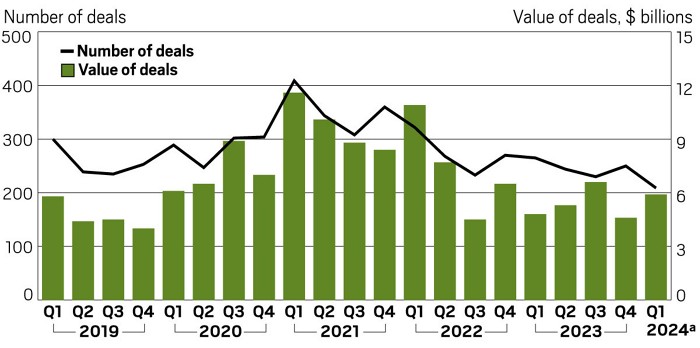
The dip is especially low among early-stage deals. Industry watchers say investors are still risk averse and, consequently, prioritizing investment in companies whose drug candidates are farther along in development.
“I think the bar is still high,” says Katie McCarthy, chief innovation officer at the Halloran Consulting Group. “Investors have really reestablished their expectations. They do want to ensure there’s a reasonable amount of risk.”
Those start-ups that have managed to buck the trend and raise “mega-rounds”—$100 million or more—have a few things in common.
For one, investors are still likely to back experienced management teams. Chris Garabedian, portfolio manager at venture firm Perceptive Advisors and CEO of the accelerator Xontogeny, points to precision medicine start-up Mirador Therapeutics. Mirador launched in March with $400 million in venture capital. What made such a young start-up a sure bet for investors, Garabedian argues, are its founders: Mark McKenna and a few other executives from Prometheus Biosciences sold their last company to Merck & Co. for $10.8 billion.
“If you can bet on a proven team . . . well, instead of putting $4 million into 10 companies, let’s put $400 million into one,” Garabedian says. “If you put $4 million into 10 companies, you diversify the risk, but you also take on more management risk.”
Similarly, Synnovation Therapeutics, a cancer start-up that debuted with $102 million in January , is led by several former executives of Incyte who had launched multiple commercial drugs during their tenure there. FogPharma, which raised $145 million in March, was founded by chemist and serial entrepreneur Greg Verdine and is currently led by Johnson & Johnson veteran Mathai Mammen.
Investors are also more inclined to fund clinically validated science—that is, drug candidates that have been tested in humans. Cour Pharmaceuticals, which closed a $105 million round in January , has multiple Phase 2 studies in progress for its nanoparticle drugs, and Latigo Biotherapeutics’ lead drug candidate for pain relief was already in Phase 1 trials when the start-up launched with $135 million in February . Latigo’s compound LTG-001 works the same way a Vertex Pharmaceuticals drug does, giving investors extra confidence since the Vertex drug recently succeeded in a Phase 3 study.
Carolina Alarco, founder and principal of the consulting firm Bio Strategy Advisors and an angel investor, worries that this creates a secondary problem: that biotech may be “losing its edge” by deprioritizing newer programs.
“Experienced CEOs and founders normally gravitate toward proven technologies and platforms to have the most likelihood of success,” Alarco says. “Young entrepreneurs and scientists, they have the true innovation. They have the real treatments that are going to come out in 10 or 20 years. I think we’re doing a disservice to science by not opening up some funding to these highly innovative approaches.”
Still, there’s plenty of capital sitting on the sidelines—and investors can only wait so long to deploy it. Venture firms typically have to write checks within a certain period of time or return the money to their own investors.
Perceptive Advisors, Garabedian’s firm, has until May 2026 to spend a $515 million fund it closed in 2021. Several other venture capital firms are approaching similar cliffs: Many closed their last funds in 2020 and 2021, when the COVID-19 pandemic sparked new interest in biotechnology investment.
The same time pressure applies for pharmaceutical companies looking to acquire smaller firms or license their assets. Arda Ural, EY’s Americas industry markets leader for health sciences and wellness, says Big Pharma has about $1.2 trillion in capital available for mergers and acquisitions, down just slightly from the $1.37 trillion the sector had in December .
Meanwhile, the expiration of several major patents means some pharmaceutical companies are staring down billions of dollars in revenue loss over the next several years, Ural says. That could eventually outweigh the macroeconomic factors that create risk, including geopolitical tensions, high interest rates, and inflation.
It would be welcome news for the 30% of biotech startups that are looking for a flash sale because they have less than a year’s worth of cash runway.
“This cannot sustain in the long term,” Ural says. “Something’s got to give.”
You might also like...

- Share on Facebook
- Share on Twitter
- Share on Linkedin
- Share on Reddit
This article has been sent to the following recipient:
Join the conversation
Contact the reporter
Submit a Letter to the Editor for publication
Engage with us on Twitter
The power is now in your (nitrile gloved) hands
Sign up for a free account to get more articles. or choose the acs option that’s right for you..
Already have an ACS ID? Log in
Create a free account To read 6 articles each month from
Join acs to get even more access to.
Advanced cell atlas opens new doors in biomedical research
Researchers at Karolinska Institutet have developed a web-based platform that offers an unprecedented view of the human body at the cellular level. The aim is to create an invaluable resource for researchers worldwide to increase knowledge about human health and disease. The study is published in Genome Biology.
Simultaneous measurement of numerous biomolecular variables, known as multi-omics, enables deep and comprehensive profiling of human biology. The new Single Cell Atlas (SCA) is based on analyses of thousands of human tissue samples from 125 different adult and fetal tissues. The researchers combined eight cutting-edge omics technologies, including single-cell RNA sequencing, whole-genome sequencing, and spatial transcriptomics to map and localise genes expressed in the tissue.
The platform provides unique insights into individual cell properties and their interactions within tissues. The extensive collection of data is freely accessible through the platform's website.
"The Single Cell Atlas not only saves time and resources but also fosters a collaborative environment for scientists from diverse fields, paving the way for new discoveries and innovations," says the study's first author Lu Pan, researcher at the Institute of Environmental Medicine, Karolinska Institutet, Sweden.
Looking ahead, the team plans to refine the SCA by introducing more detailed analyses and annual updates. These enhancements will fill gaps in tissue representation and expand the sample size, allowing for more precise research.
"The creation of the SCA marks a significant step forward in biomedical research," says the study's last author Xuexin Li, researcher at the Department of Physiology and Pharmacology (previously at the Department of Medical Biochemistry and Biophysics), Karolinska Institutet. "Our goal is to continually enrich the atlas, making it an invaluable resource for understanding human health and disease."
The research was done in collaboration with China Medical University and several other international collaboration partners in The Single Cell Atlas Consortium. The study was financed by Karolinska Institutet and the KI Network Medicine Global Alliance (KI NMA). Coauthor Volker Lauschke is CEO and shareholder of HepaPredict AB, co-founder and shareholder of PersoMedix AB, and discloses consultancy work for Enginzyme AB. The other authors declare that they have no competing interests.
- Human Biology
- Medical Topics
- Diseases and Conditions
- Personalized Medicine
- Biotechnology and Bioengineering
- Biochemistry Research
- Developmental Biology
- Health science
- Stem cell treatments
- Scientific method
- Public health
- Veterinary medicine
- Thyroid hormone
- Electron microscope
Story Source:
Materials provided by Karolinska Institutet . Note: Content may be edited for style and length.
Journal Reference :
- Lu Pan, Paolo Parini, Roman Tremmel, Joseph Loscalzo, Volker M. Lauschke, Bradley A. Maron, Paola Paci, Ingemar Ernberg, Nguan Soon Tan, Zehuan Liao, Weiyao Yin, Sundararaman Rengarajan, Xuexin Li. Single Cell Atlas: a single-cell multi-omics human cell encyclopedia . Genome Biology , 2024; 25 (1) DOI: 10.1186/s13059-024-03246-2
Cite This Page :
Explore More
- New Circuit Boards Can Be Repeatedly Recycled
- Collisions of Neutron Stars and Black Holes
- Advance in Heart Regenerative Therapy
- Bioluminescence in Animals 540 Million Years Ago
- Profound Link Between Diet and Brain Health
- Loneliness Runs Deep Among Parents
- Food in Sight? The Liver Is Ready!
- Acid Reflux Drugs and Risk of Migraine
- Do Cells Have a Hidden Communication System?
- Mice Given Mouse-Rat Brains Can Smell Again
Trending Topics
Strange & offbeat.

IMAGES
VIDEO
COMMENTS
Biotechnology is a broad discipline in which biological processes, organisms, cells or cellular components are exploited to develop new technologies. New tools and products developed by ...
Biotechnology is an evolving research field that covers a broad range of topics. Here we aimed to evaluate the latest research literature, to identify prominent research themes, major contributors in terms of institutions, countries/regions, and journals.
First published: April 18, 2024. Microbial infections are major human health issues, and, recently, the mortality rate owing to bacterial and fungal infections has been increasing. In addition to intrinsic and extrinsic antimicrobial resistance mechanisms, biofilm formation is a key adaptive resistance mechanism.
An urbanizing population—estimated to be 6.3 billion people (66% of the world) by 2050—will drive new biotech solutions for sanitary, microbe surveillance, and waste recycling systems.
Optobiomechanics of the Eye. Sabine Kling. Jos J. Rozema. Anna Marina Pandolfi. Norberto López Gil. 352 views. A multidisciplinary journal that accelerates the development of biological therapies, devices, processes and technologies to improve our lives by bridging the gap between discoveries and their appl...
If you're just starting out exploring biotechnology-related topics for your dissertation, thesis or research project, you've come to the right place. In this post, we'll help kickstart your research topic ideation process by providing a hearty list of research topics and ideas, including examples from recent studies.. PS - This is just the start…
Current Research in Biotechnology (CRBIOT) is a new primary research, gold open access journal from Elsevier.CRBIOT publishes original papers, reviews, and short communications (including viewpoints and perspectives) resulting from research in biotechnology and biotech-associated disciplines. Current Research in Biotechnology is a peer-reviewed gold open access (OA) journal and upon acceptance ...
Dive into the world of 200+ biotechnology research topics, from genetic engg to emerging trends. Explore the future of innovation in all sectors. ... Keep up with the latest developments and trends in biotechnology. Subscribe to scientific journals, attend conferences, and follow reputable websites to stay informed about cutting-edge research. ...
8. Lab-Grown Organs. One of the most exciting developments in biotech has been the creation of lab-grown organs. Using a patient's own cells, scientists can now cultivate organs in the lab that ...
Biotechnology News. Read the latest research from around the world on genetic engineering, drug development and more.
With new access to data from the 3.4 billion+ COVID-19 mRNA vaccines that have been administered worldwide, researchers have been able to determine the risks associated with mRNA vaccines, which brings forward new topics for research in the medical and pharmaceutical sides of the biotech industry. mRNA vaccines are faster to develop and can ...
Startups probe hidden viruses in the 'dark genome' to treat disease. Drug hunters are finding that ancient virus-like artifacts in the human genome could offer new avenues to treat ...
The Plant Biotechnology section at Frontiers in Plant Science mainly publishes applied studies examining how plants can be improved using modern genetic techniques (Lloyd and Kossmann, 2021). This Research Topic was designed to allow editors from the section to highlight some of their own plant biotechnological work.
Biotechnology is a dynamic field that continuously shapes our world, enabling innovation, breakthroughs, and solutions to various challenges. As we move into the future, numerous emerging research areas promise to revolutionize healthcare, agriculture, environmental sustainability, and more. The top 50 emerging research topics in biotechnology are presented in this article.
Read the latest news focusing on Biotech drug developments, clinical research and pharmaceuticals.
Look at some of the top trends in biotech research and recent Biotechnology Topics that are bringing massive changes in this vast world of science, resulting in some innovation in life sciences and biotechnology ideas. Development of vaccine: Development of mRNA has been done since 1989 but has accelerated to combat the pandemic. As per many ...
The aim of this Research Topic collection is to highlight the latest advancements, gaps in research and future trends across the food biotechnology industry, with a particular emphasis on the nutritional composition of foods. Original Research Articles, Review Articles, Mini Reviews and Perspective Articles on recent developments in ...
Find breaking science news and analysis from the world's leading research journal.
Biotechnology Research Paper Topics. This collection of biotechnology research paper topics provides the list of 10 potential topics for research papers and overviews the history of biotechnology. The term biotechnology came into popular use around 1980 and was understood to mean the industrial use of microorganisms to make goods and services ...
From an early age, Allison Keeler '05 (biotechnology) always knew she wanted to be a scientist.As an adult, that dream has come true as she is an assistant professor in the Department of Pediatrics at the University of Massachusetts (UMass) Chan Medical School and the lead researcher in the Keeler Lab within the Horae Gene Therapy Center.. Keeler applied early to RIT, out of her high school ...
As the biotechnology scope is expanding day by day, researchers felt an urge to classify main areas and types of biotechnology depending on some commonalities and their ultimate objectives: List of Biotechnology Research Topics for high school, college and PHD research students in areas of food, agriculture, medical, environment.
In the first quarter of this year, biotechnology and pharmaceutical companies collectively raised $5.9 billion across 209 rounds, according to the latest Venture Monitor report from PitchBook and ...
Advanced cell atlas opens new doors in biomedical research. ScienceDaily . Retrieved April 26, 2024 from www.sciencedaily.com / releases / 2024 / 04 / 240425131351.htm
There's a hot new trend for healthcare investors, but it's generating quite a bit of controversy. Publicly traded biotech companies are increasingly turning to PIPEs, or private investments in ...